A harrowing, historic week in Egypt
The Beginning
Collected,Edited And Reported By:
Pilot: Tarek Elagamy
They have been days of chants and chaos, bloodshed mixed with moments of breathtaking solidarity between the protesters and the soldiers sent to subdue them. The flame of social unrest that first flickered in Tunisia has spread to Egypt, culminating with the announcement Tuesday by President Hosni Mubarak that after three decades in power, he would not run for another term. The clashes left government buildings in ashes, stores ransacked, and an economy teetering. Cairo's international airport teemed with Americans and other foreigners trying to flee; Egypt's tourism industry froze. At Cairo's Liberation Square, Mubarak's announcement was met with jeers and calls for an immediate resignation. Pro-Mubarak forces struck back, attacking the protesters in waves. The country of 80 million, rich in history but bereft of personal freedoms, awaits the next stage. Collected here are images from the last week focusing inside Egypt.
President Hosni Mubarak, in a taped speech shown Tuesday night, announces he would not run for reelection. It's unclear whether a majority of Egyptians will support his staying in office until September, when elections are scheduled. The reaction on Liberation Square, where tens of thousands of protesters watch the speech, is unequivocal: The president must go now. (Chris Hondros/Getty Images)

2An army soldier tries to contain thousands of pro-government supporters of President Hosni Mubarak pushing their way on Wednesday, Feb. 2, past a military checkpoint and toward Tahrir Square in central Cairo. The supporters later attacked protesters, with running battles throughout the capital. (Yannis Behrakis/Reuters) #

3Pro-Mubarak supporters come out in the thousands in Cairo on Wednesday, Feb. 2, proudly carrying images of the leader, images that the protesters have been defacing for the past eight days. (Peter Macdiarmid/Getty Images) #

4Surging through the crowd in Liberation Square in Cairo, government supporters on camels and horses attack demonstrators with batons and rocks on Wednesday, Feb. 2. The violence followed a scene of jubilation the day before, when a quarter million people filled the square in a mostly peaceful rally, anticipating that their days of rallies had pushed President Mubarak, the longest serving leader of modern Arab history, to the end of his reign. (Chris Hondros/Getty Images) #

5Clashes between anti-government protesters and police were frequent in the early days of protests. On Jan. 26, a group of demonstrators scuffles with police in Cairo. Some protesters have accused the police of trying to infiltrate opposition groups and foment violence. Most opposition groups have long maintained an antipathy toward elements of the police force, whom they consider enforcers of government tyranny and henchmen for President Mubarak. (Amr Abdallah Dalsh/Reuters) #

6On Sunday, Jan. 30, a variety of emotions permeate Liberation Square, but one demand remains constant: President Mubarak must go. By day's end, disparate Egyptian opposition groups have united in backing opposition leader Mohamed ElBaradei as their spokesman.(Yannis Behrakis/Reuters) #

7For the young protesters in Cairo -- the majority of the demonstrators have been under 30 -- President Hosni Mubarak is the only leader they have known. For most of their lives, images of the president had been revered. In protests Saturday, photos of the president are defaced, burned, stepped on, and spat upon. (Mohammed Abu Zaid/Associated Press) #

8Protests turn violent on Saturday, Jan. 29, as demonstrators set a police station afire in Giza, near the ancient pyramids. Within days, the Egyptian military had sealed the area around the pyramids and other historic sites in an effort to protect them. Tourism has been one of Egypt's main industries. (Victoria Hazou/Associated Press) #

9Mariam Solayman, a member of an Egyptian activist group, shouts anti-government slogans during a demonstration outside the press syndicate in central Cairo Thursday, Jan. 27. In the early days of the protests, most of the demonstrators were pro-democracy groups; by the weekend, however, Islamist groups such as the Muslim Brotherhood, which has been banned in Egypt for decades, joined the rallies. (Yannis Behrakis/Reuters) #
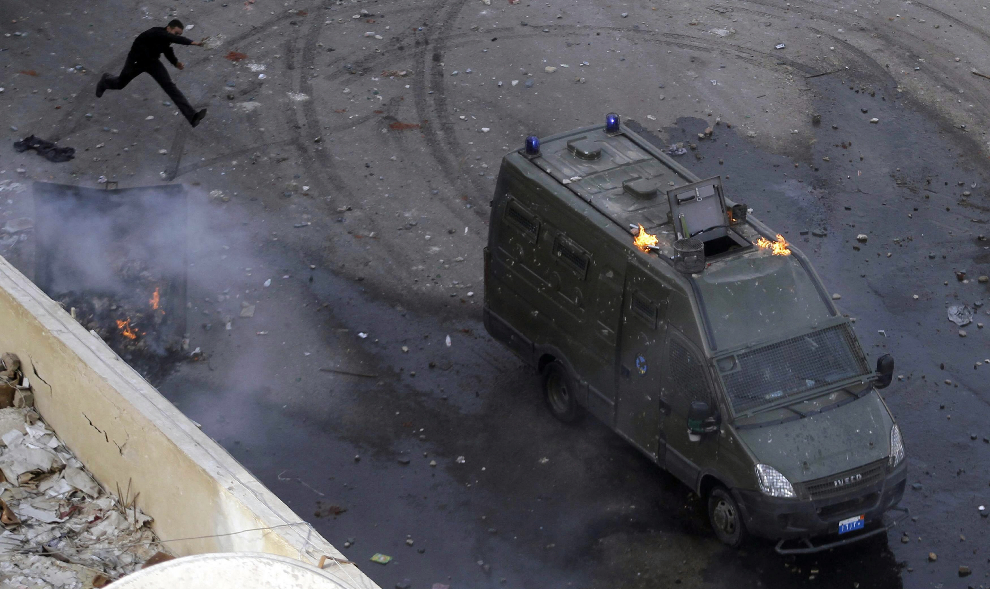
10Protests had been particularly violent in the port city of Suez, 83 miles east of Cairo. On Thursday, Jan. 27, protesters attempted to firebomb a riot police car. Police in turn fired rubber bullets, water cannons, and tear gas at hundreds of demonstrators. At least one officer was killed in Suez that day. (Mohamed Abd El-Ghany/Reuters) #

11A lone protester waves an Egyptian flag atop a lamp post in Liberation Square Tuesday, Feb. 1, as hundreds of thousands of compatriots call on President Mubarak to step down now. Mubarak has towered over Middle East politics for 30 years, assuming the presidency in 1981 when Anwar Sadat was assassinated, just yards from where Mubarak took cover. Sadat was killed for reaching out to the Israelis and signing the first peace treaty between the historic enemies. Mubarak has been one of the United States' most stalwart supporters in its quest for a more comprehensive Middle East peace. (Yannis Behrakis/Reuters) #
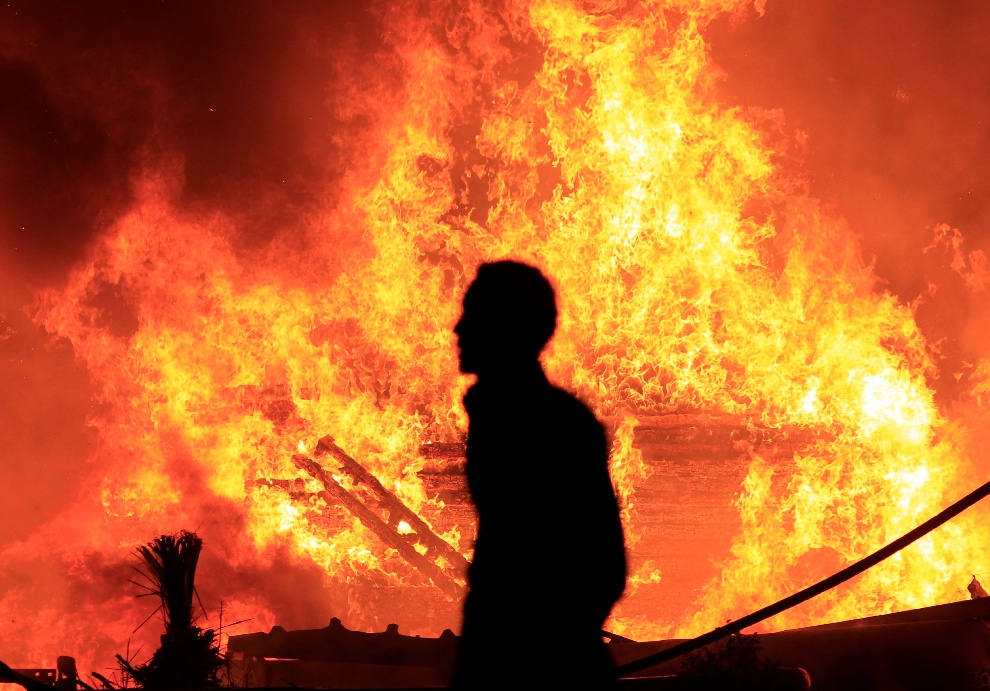
12Protests turned violent in Cairo on Friday, Jan. 28, as huge, angry crowds packed the squares of downtown Cairo. By the end of the day, several police stations and the headquarters of President Mubarak's governing party were in flames. Mubarak ordered army troops into the cities in an attempt to support the much-hated police force and quell the violence. By midnight, the president, in a midnight speech, said he would fire his ministers and name a new Cabinet. That did little to slow the street uprising against him. (Goran Tomasevic/Reuters) #
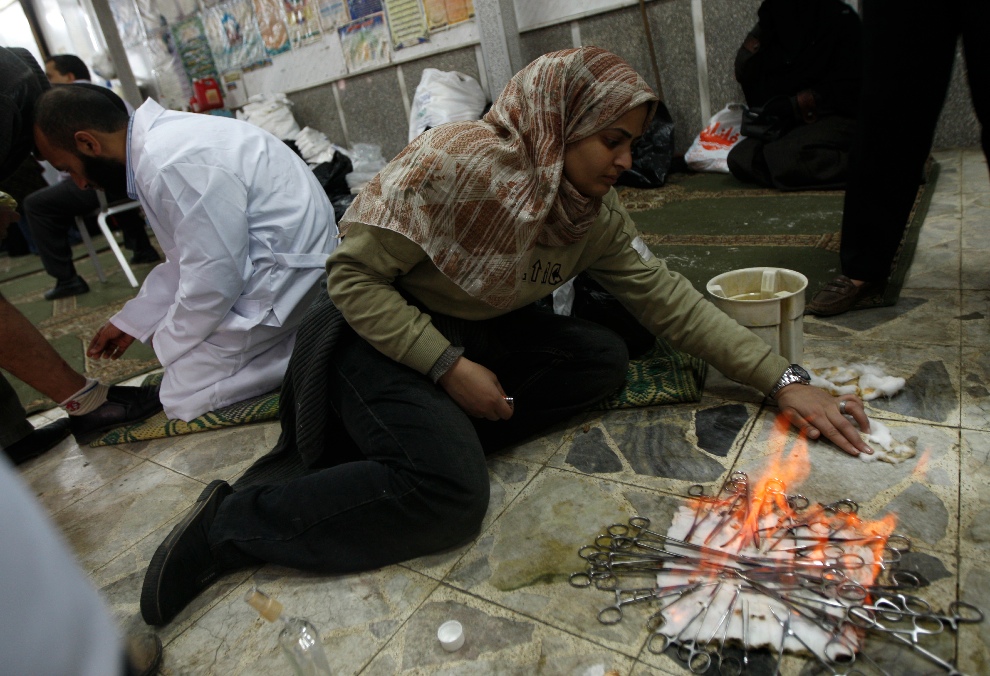
13A woman sterilizes scissors as a doctor treats a wounded person in a Cairo mosque on Sunday, Jan. 30. Reports from aid agencies and charities suggest that 300 had died in the violence from Jan. 25 to Feb.1. "It's a very unconfirmed number," Rupert Colville, spokesman for the UN High Commissioner for Human Rights, told Bloomberg News. (Khalil Hamra/Associated Press) #
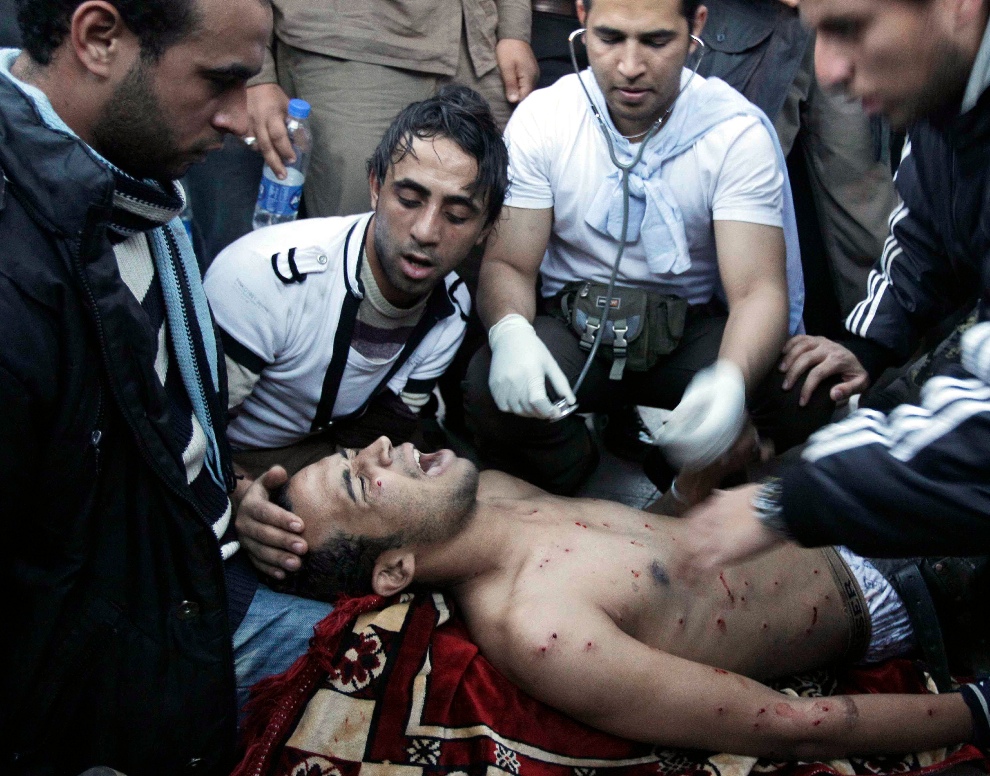
14A man, who gave his name as Maged Mahmoud, receives help after he was injured during clashes with riot police in Cairo on Friday, Jan. 28. Police used buckshot and pepper spray, among other weapons, in attempt to disperse the crowds. (Ben Curtis/Associated Press) #
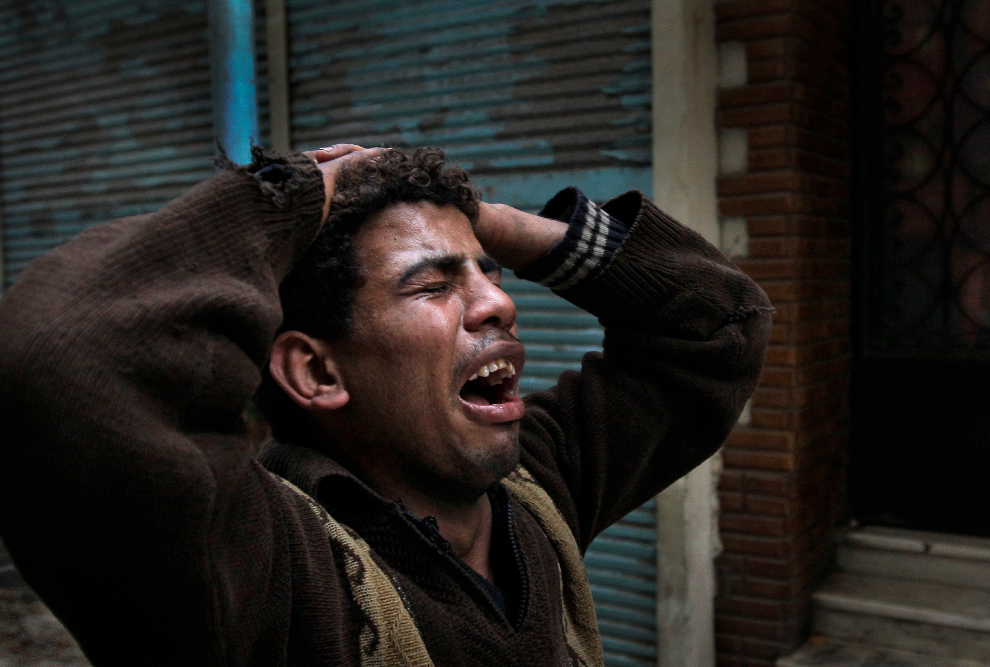
15Moments after seeing the body of a protester shot by police in Liberation Square Friday, Jan. 28, a demonstrator walks away. (Ben Curtis/Associated Press) #

16On Saturday, Jan. 29, it was reported that thousands of inmates from the Wadi Naturn prison had escaped. By then, most of the police force had abandoned the streets, leaving homeowners and shopkeepers to their own devices in Cairo. For many residents, this meant taking matters -- and weapons -- into their own hands. They formed neighborhood watch groups, armed with everything from PVC pipe to chains to guns. (Chris Hondros/Getty Images) #
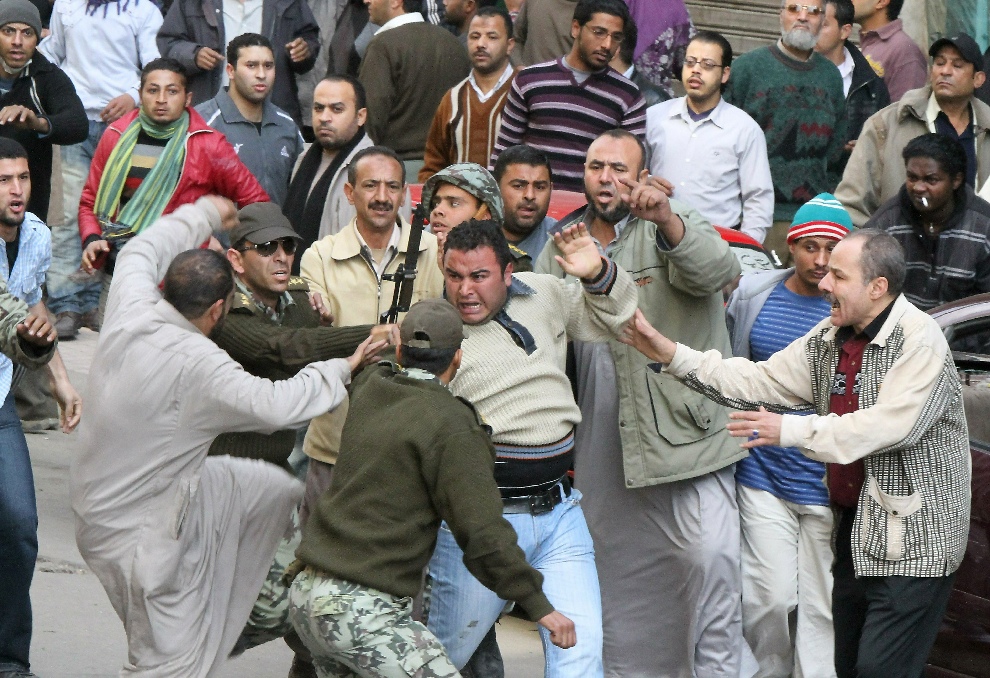
17Egyptian soldiers try to protect a man from angry protesters who thought he was a plainclothes policeman on Monday, Jan. 31. The military is generally respected by the protesters; police officers, however, are reviled. Some protesters have said some undercover police officers have tried to infiltrate opposition groups in an attempt to create violence and gather information. (Khaled Desouki/AFP/Getty Images) #
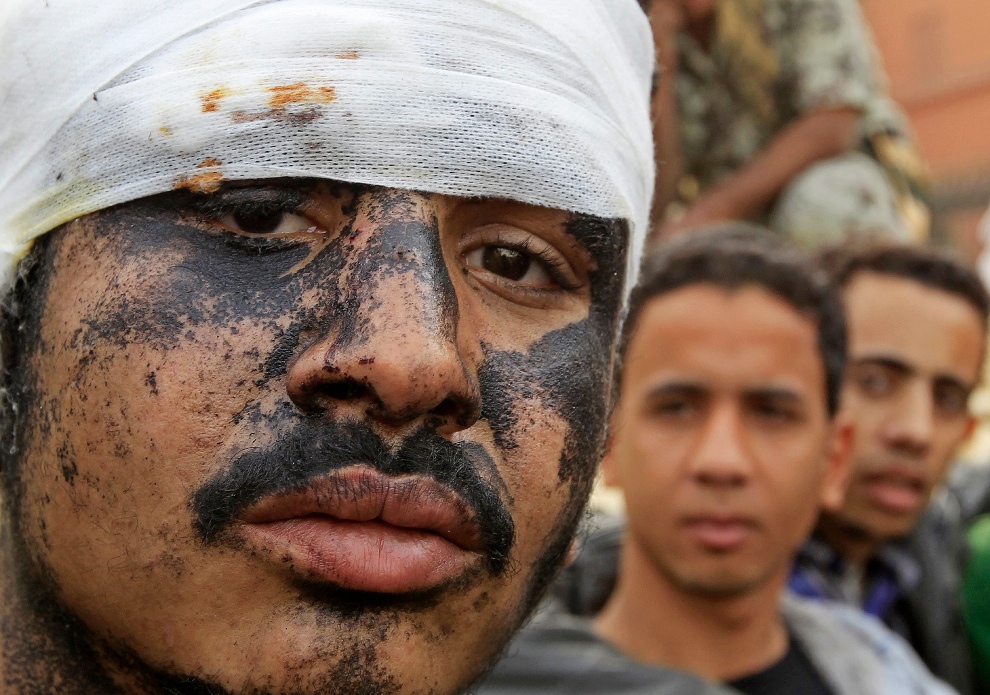
18Injuries did not stop a man from standing in front of an Egyptian army vehicle during a protest in Cairo on Saturday, Jan. 29. (Goran Tomasevic/Reuters) #
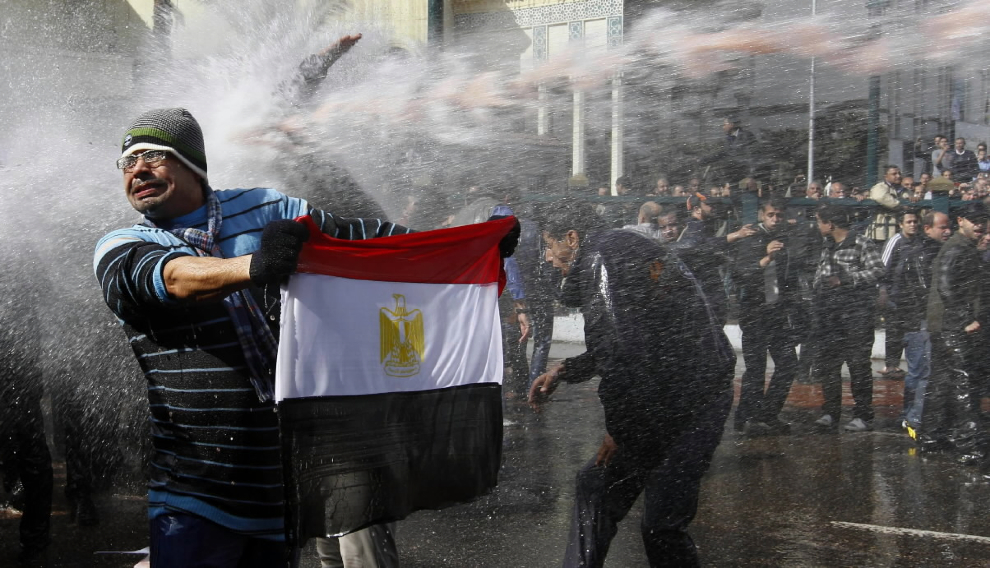
19A protester holds an Egyptian flag as he dodges a blast from a water cannon during clashes in Cairo on Friday, Jan. 28, one of the most violent days of the street uprising so far. Tens of thousands took to the streets of Cairo. For much of the day, police and demonstrators fought running battles through the squares and back alleys of Egypt's capital. (Yannis Behrakis/Reuters) #
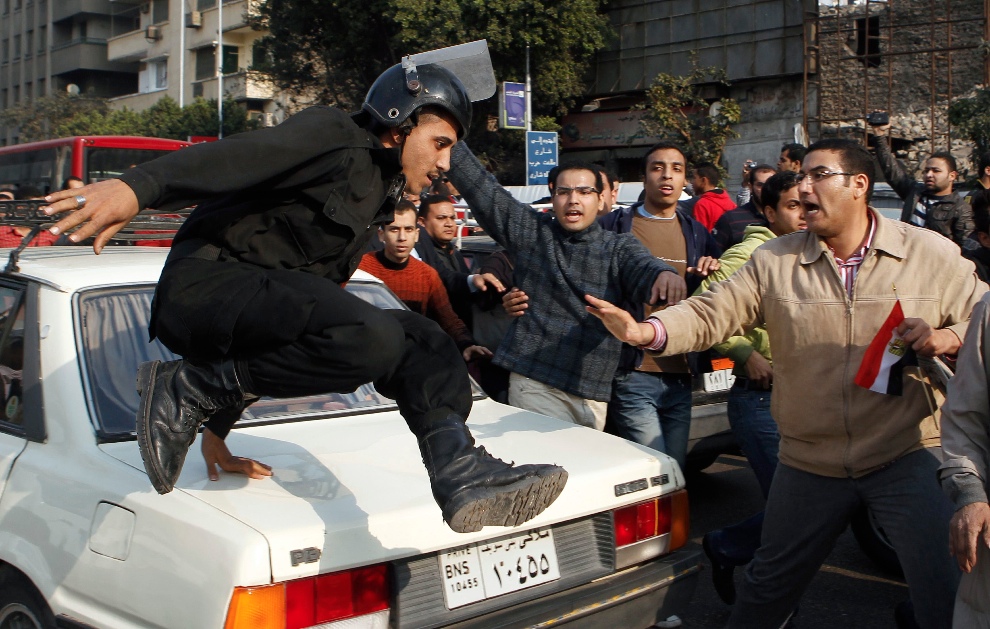
20A riot police officer jumps over a car and toward anti-government protesters in downtown Cairo on Tuesday, Jan. 25, the first day of protests. (Amr Abdallah Dalsh/Reuters) #
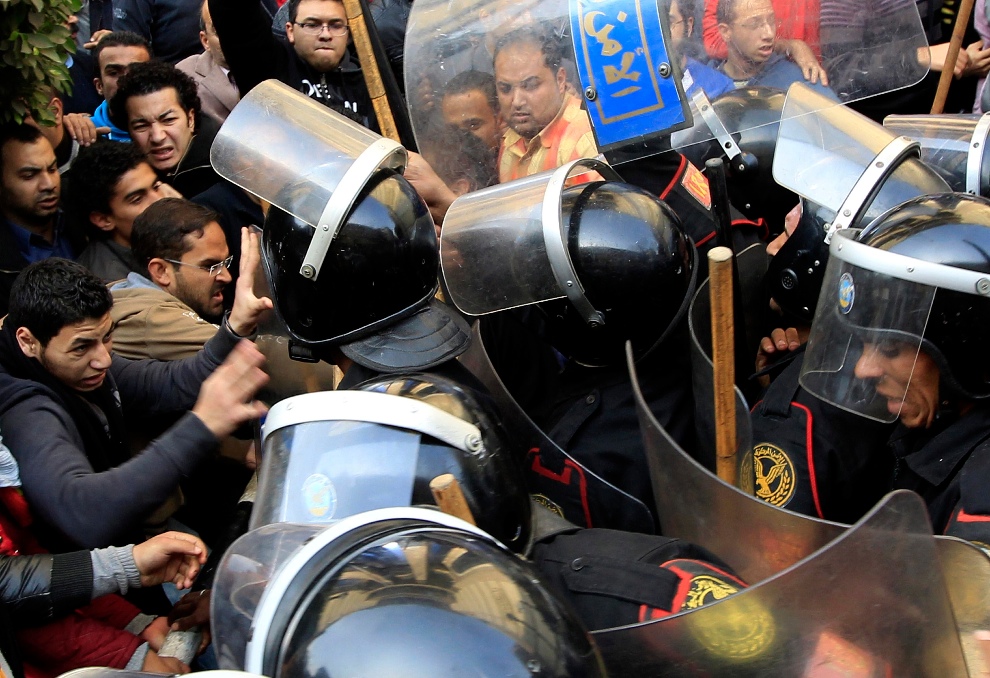
21Wielding shields and batons, riot police clash with protesters in Cairo on Wednesday, Jan. 26. (Goran Tomasevic/Reuters) #
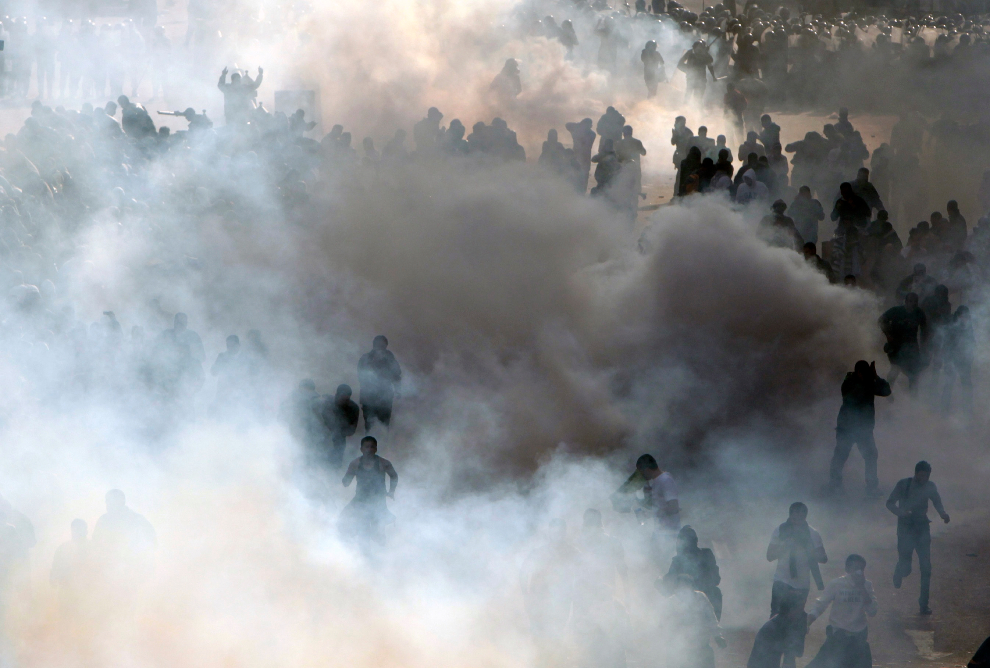
22Protesters flee through a cloud of tear gas during clashes in Cairo on Friday, Jan. 28. (Amr Abdallah Dalsh/Reuters) #

23Protesters pray in front of an Egyptian army tank in Liberation Square in Cairo Saturday, Jan. 29. In several parts of the city, confrontation gave way to camaraderie as protesters and soldiers shared water bottles and stories. (Lefteris Pitarakis/Associated Press) #

24A soldiers directs demonstrators arriving at Liberation Square Tuesday morning, Feb. 1, in Cairo for the biggest demonstration of the uprising so far. More than a quarter-million people flooded into the heart of Cairo. The rally, which cut across lines of piety and party, was mostly peaceful. Middle East observers say the role of the military is key to how long President Mubarak will remain in power. Without its support, the president has little leverage. (Ahmed Ali/Associated Press) #

25An army captain identified as Ihab Fathi holds the national flag while being carried by demonstrators during a protest Sunday, Jan. 31, in Liberation Square. As the days of protests continued, there were more and more examples of the military sympathizing with the aims of the protesters. (Marco Longari/AFP/Getty Images) #

26After clashing with protesters in Liberation Square Saturday, Jan. 29, a soldier rests curbside. (Amr Abdallah Dalsh/Reuters) #

27A protester places empty shotgun shells on his fingers during a rally in Liberation Square in Cairo on Monday, Jan. 31. (Suhaib Salem/Reuters) #

28The dozens of rallies have been alternatively tense, surreal, and frightful, and, at times, whimsical. In between chants against at the government of President Mubarak, demonstrators break out in a dance -- with one of them balancing a broom on his chin -- during a massive rally Tuesday, Feb. 1, at Liberation Square in Cairo. (Emilio Morenatti/Associated Press) #

29The colors of the Egyptian flag fill the face of a youngster during demonstrations in Liberation Square in Cairo Tuesday, Feb. 1. (Dylan Martinez/Reuters) #

30On Saturday, Jan. 29, the army is sent into the streets to quell the protests, where they are greeted with cheers and open arms in some parts of the country, including Liberation Square in Cairo. The army is one of the most respected institutions in Egypt. By Monday, their leaders had vowed not to fire on protesters. (Chris Hondros/Getty Images) #

31A woman carries a flower amid the protesters in Liberation Square Tuesday, Feb. 1. (Tara Todras-Whitehill/Associated Press) #
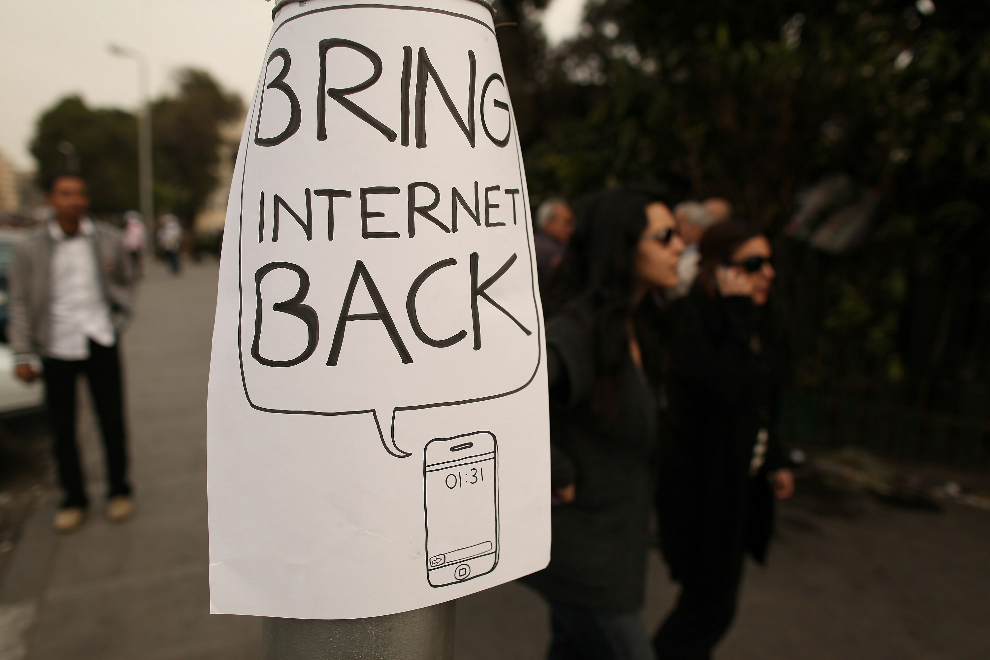
32The battle between the government and protesters has not been limited to the streets and squares of cities. A cyber-skirmish has also broken out, as the government has blocked access to the Internet and Twitter. Protesters, who used Facebook and other websites as well as cellphones and instant messaging to coordinate rallies, retaliated by using special software that allowed them to circumvent the censorship. Some of the software was provided by Tor, a group based in Walpole, Mass. (Peter Macdiarmid/Getty Images) #

33The unrest has created a chaotic situation at Cairo's international airport, as Americans and other foreigners sought to leave Egypt. Thousands of would-be passengers have been stranded as nations around the world scrambled to send in planes to fly their citizens out. By early this week, 3,100 US citizens had contacted the American Consulate. (Victoria Hazou/Associated Press) #

34Camel driver Gamal, 54, is without work near the pyramids, in Giza on Monday, Jan. 31. The government closed access to pyramids in an attempt to protect the national treasures. The pyramids draw millions of visitors a year. (Emilio Morenatti/Associated Press) #
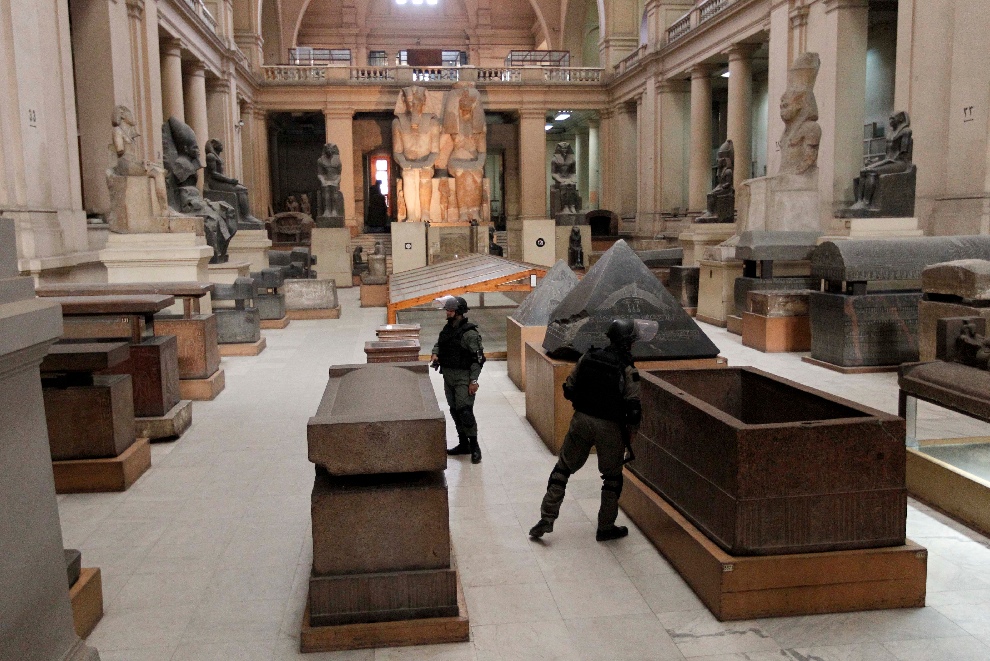
35Egyptian special forces secure the main floor inside the Egyptian Museum in Cairo on Monday, Jan. 31. Would-be looters broke into the famed museum on Saturday ripping the heads off two mummies and damaging some artifacts before being caught and detained by army soldiers, Egypt's antiquities chief Zahi Hawass said the prized collection is secure from thieves and under military guard.(Tara Todras-Whitehill/Associated Press)#

36Local men sit next to closed shops on Monday, Jan. 31, in Cairo. In addition to exacting a political toll, the uprising has battered Egypt's economy, costing the country and its citizens billions of dollars and battering the Egyptian stock market. (Peter Macdiarmid/Getty Images) #
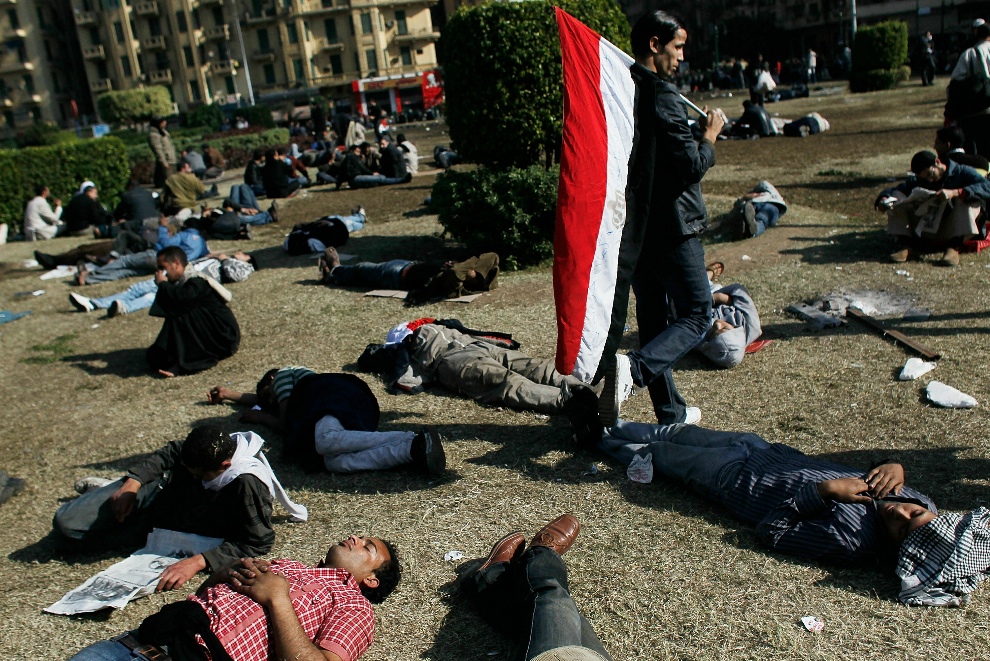
37Exhausted Egyptians rest on the grass in Liberation Square on Sunday, Jan. 30, after days of protests. (Chris Hondros/Getty Images) #
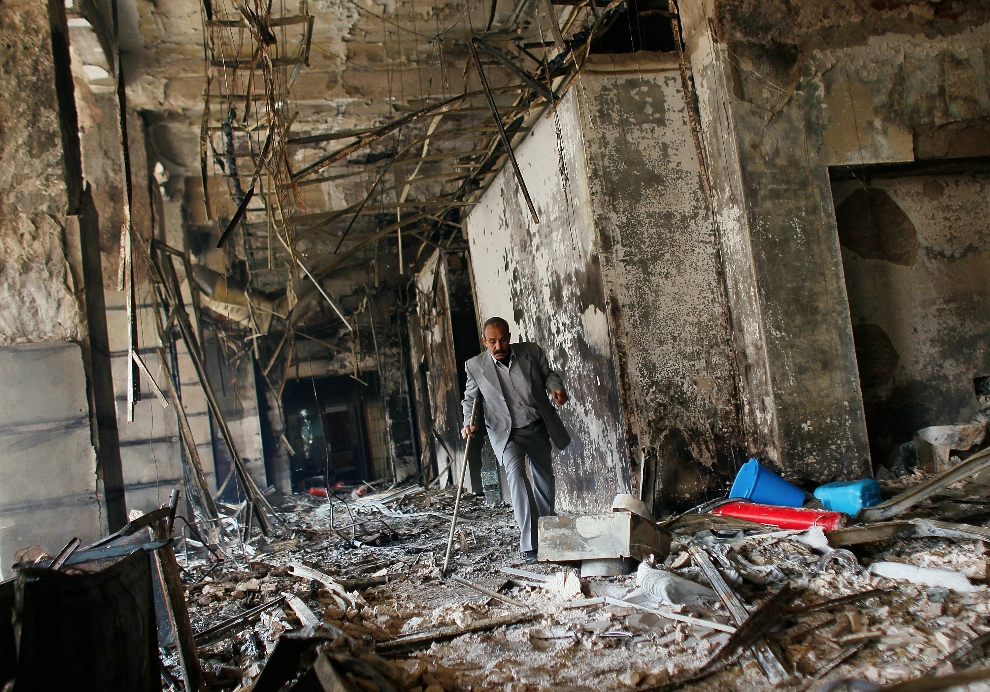
38The charred remains of a government building in Cairo makes for difficult passage for a pedestrian on Sunday, Jan. 30. (Chris Hondros/Getty Images) #

39An Egyptian man uses his mobile phone to take a picture of the Arcadia shopping center, which was looted and set on fire in Cairo on Sunday, Jan. 30. (Lefteris Pitarakis/Associated Press) #
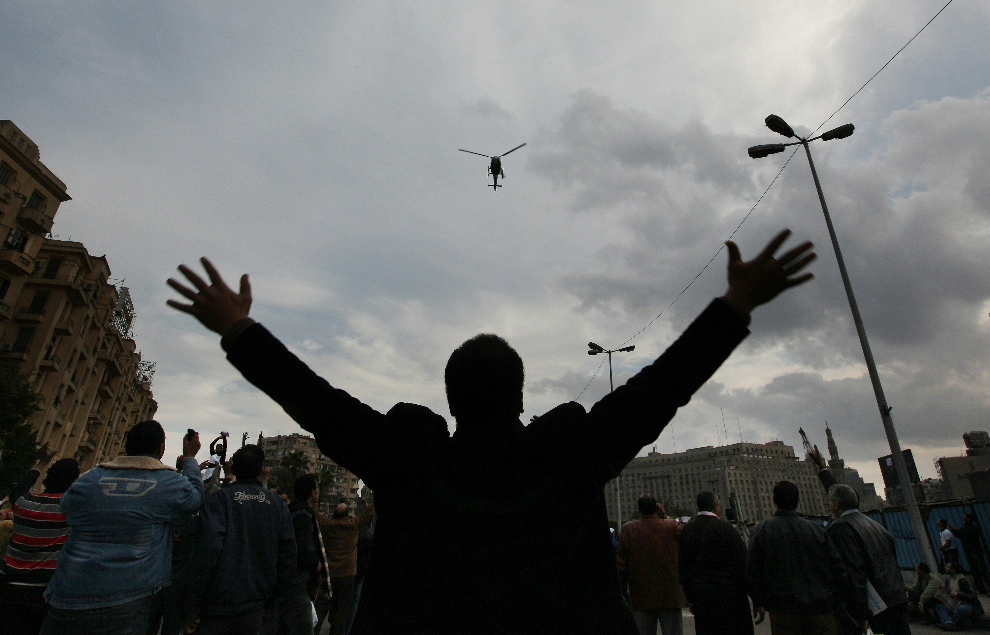
40Protesters in Liberation Square gesture at a low-flying police helicopter as the curfew begins on Sunday, Jan. 30. The curfew, imposed by President Mubarak, has largely been ignored by the masses of demonstrators. (Peter Macdiarmid/Getty Images) #
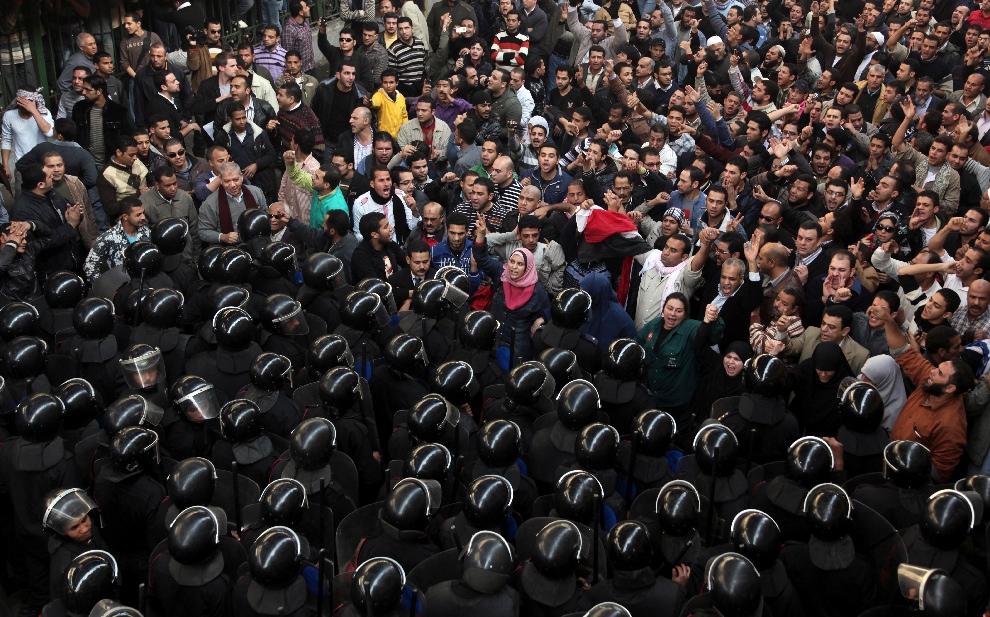
41The lines of confrontation are stark on one of the most violent days of the protests: Friday, Jan. 28, in Cairo. Tens of thousands of anti-government protesters stoned police, who fired back with rubber bullets, tear gas, and water cannons. What began days earlier as scattered protests has coalesced into a powerful movement shaking the foundation of Egypt's government, with ripples crossing the Middle East. (Victoria Hazou/Associated Press) #
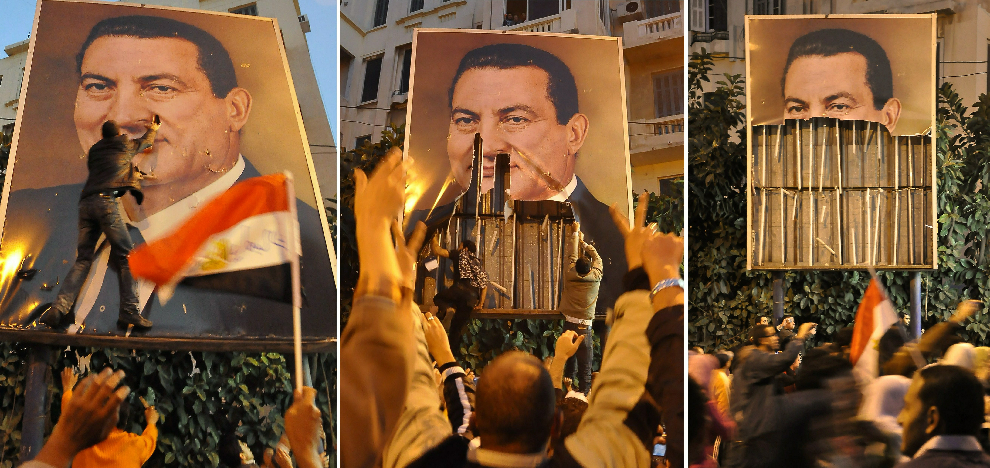
42In a series of photos on Thursday, Jan. 27, demonstrators in the port city of Alexandria dismantle the image of a dominant force in the Middle East in the past quarter century -- Hosni Mubarak. In the days that followed, the support from within Egypt and throughout the world for Mubarak would similarly evaporate. (AFP/Getty Images) #
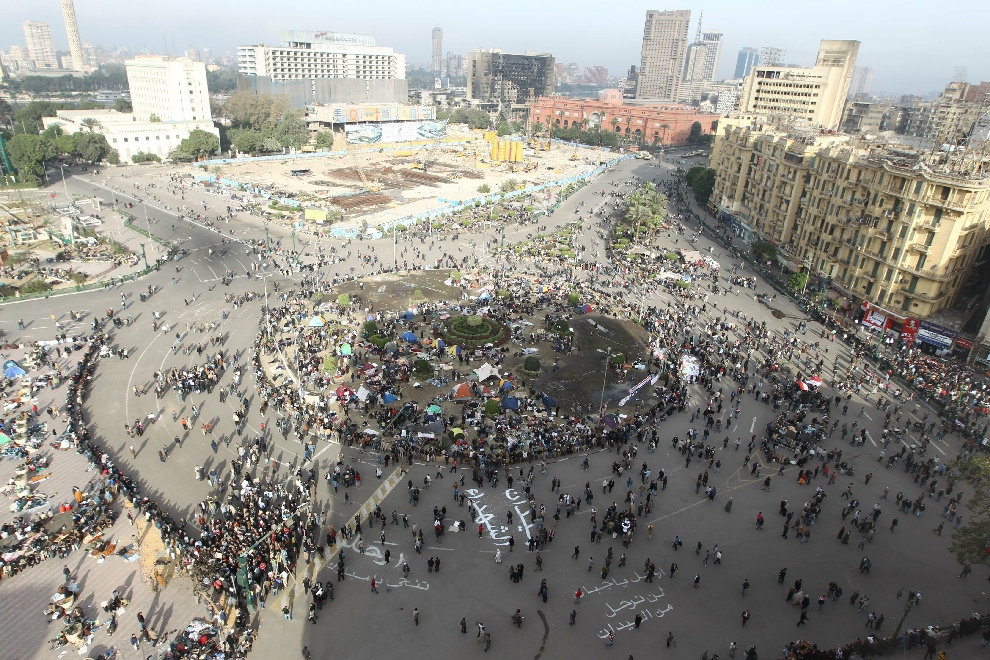
43The day of protest on Tuesday starts early for many Egyptians, as thousands begin to converge on Liberation Square, also known as Tahrir Square. Many of the protesters had camped out in the square the night before. By the end of the day, 250,000 demonstrators would fill the area. (Khaled Desouki/AFP/Getty Images)#

44About 250,000 Egyptians, from students to doctors to the indigent, jam Liberation Square by late afternoon Tuesday. The show of solidarity against President Mubarak prompts the United States to send a special envoy to Cairo, urging Mubarak to step down. (Amr Abdallah Dalsh/Reuters)#
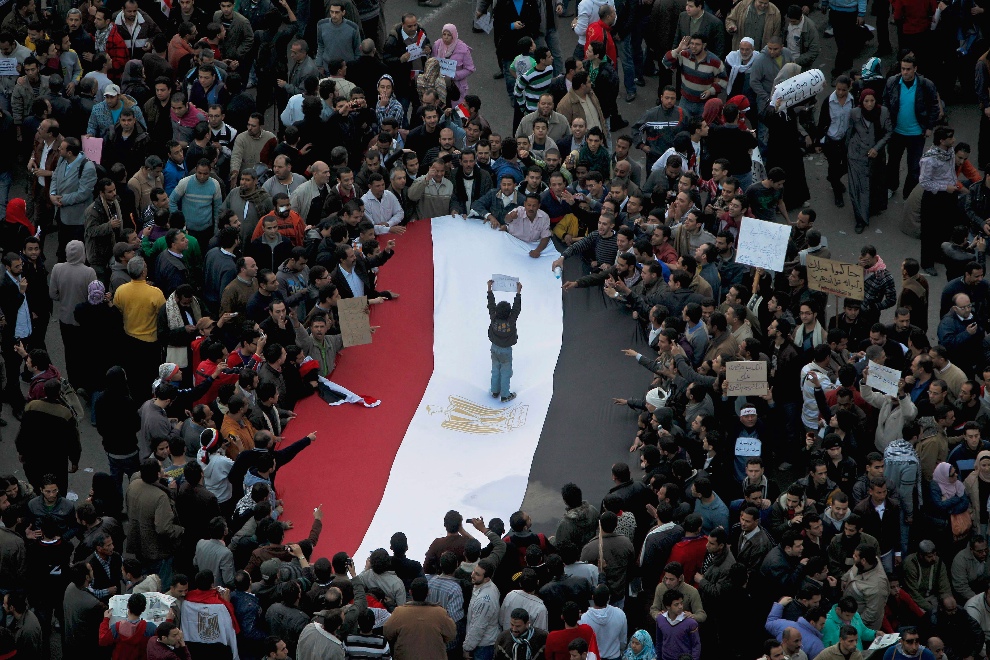
45Liberation Square in Cairo has been ground zero for a series of government-rattling protests across Egypt. On Tuesday, the largest crowd yet -- a quarter million people -- gathers on the square as a youth stands on Egypt's national flag. For the protesters, the rally capped a week of an unceasing, and sometimes violent, push to force the ouster of President Hosni Mubarak after nearly 30 years in power. (Tara Todras-Whitehill/Associated Press)
Egypt in 2011 after revolution : the wait
For 17 days, tens of thousands of anti-government protesters gathered in Tahrir Square calling for the resignation of President Hosni Mubarak, 30 years in power. They had been acting out of passion for their country and dedication for change. They had protested and waited for a response. The response came in an address from Mubarak to the country and his people. Mubarak would not step down. Then almost miraculously, on the eighteenth day of protests, Vice President Omar Suleiman made a very brief statement on state television. Mubarak had stepped down. The crowds erupted "Egypt is free!" "Egypt is free
Anti-government demonstrators wait for the announced address by President Hosni Mubarak at a coffee shop near Cairo's Tahrir Square on the 17th day of protests calling for the ousting of the embattled leader. (Marco Longari/AFP/Getty Images)

2Demonstrators say evening prayers in front of armored personnel carriers as tens of thousands gather at Tahrir Square, also known as Liberation Square. (Pedro Ugarte/AFP/Getty Images) #

3Chanting slogans, protesters had been in a festive mood before President Mubarak spoke. News and rumors throughout the day had signaled Mubarak -- for many of the young protesters, the only president they have known -- would resign. (Pedro Ugarte/AFP/Getty Images) #

4A demonstrator waves his national flag in front of an army tank in Tahrir Square. The Egyptian army is the key player in the standoff between Mubarak and the protesters, Middle East experts say. The military, which is generally well regarded by the protesters, has largely maintained a hands-off policy during the rallies. (Pedro Ugarte/AFP/Getty Images) #

5Hassan al Roueini, military commander for the Cairo area, joins protesters in Tahrir Square. "All your demands will be met today,’’ he tells the jubilant crowd, who responded, "The people want the end of the regime,’’ and "God is great." (Suhaib Salem/Reuters) #

6Demonstrators kiss an Egyptian soldier in Tahrir Square. Through much of the 17 days of protests, soldiers and demonstrators have shown moments of solidarity. (Asmaa Waguih/Reuters) #

7After Egypt's military announced on national television that the protesters’ demands would be met, the crowd celebrates. That joy turned to seething anger hours later when President Mubarak vowed to stay in office until September. (Tara Todras-Whitehill/Associated Press) #

8Opposition supporters wait for President Mubarak's national address in Tahrir Square. (Goran Tomasevic/Reuters) #

9Opposition supporters flash the victory sign after a senior army general addressed the crowd inside Tahrir Square. (Yannis Behrakis/Reuters) #

10Demonstrators wait for the announced address by President Mubarak at a coffee shop near Tahrir Square. (Marco Longari/AFP/Getty Images) #
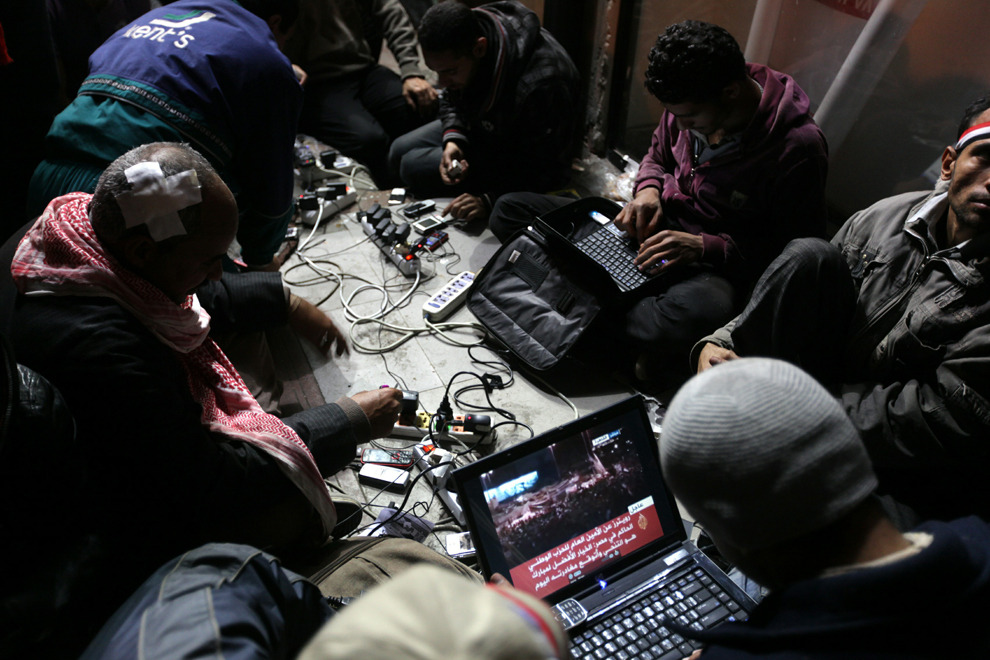
11Anti-government bloggers work on their laptops from Tahrir Square. Despite government attempts to shut down the Internet and limit communications, organizers have been adept at using a variety of media and electronic workarounds to coordinate the rallies. (Patrick Baz/AFP/Getty Images) #

12Protesters in Tahrir Square display a giant poster showing "the martyrs of the revolution." When Egypt's military announced on national television it had stepped in to secure the country and promised protesters that all their demands would soon be met, the crowd broke into chants of "We're almost there, we're almost there" and waved V-for-victory signs. (Amr Nabil/Associated Press) #

13Opposition protesters scream their support in their stronghold of Tahrir Square. (Goran Tomasevic/Reuters) #

14Opposition supporter waves flags after a senior army general addressed the crowd inside Tahrir Square. (Yannis Behrakis/Reuters) #

15A soldier watches as protesters pray in Tahrir Square. In addition to the rally in Cairo, thousands of state workers and impoverished Egyptians launched strikes and protests around the country over their economic woes. (Emilio Morenatti/Associated Press) #
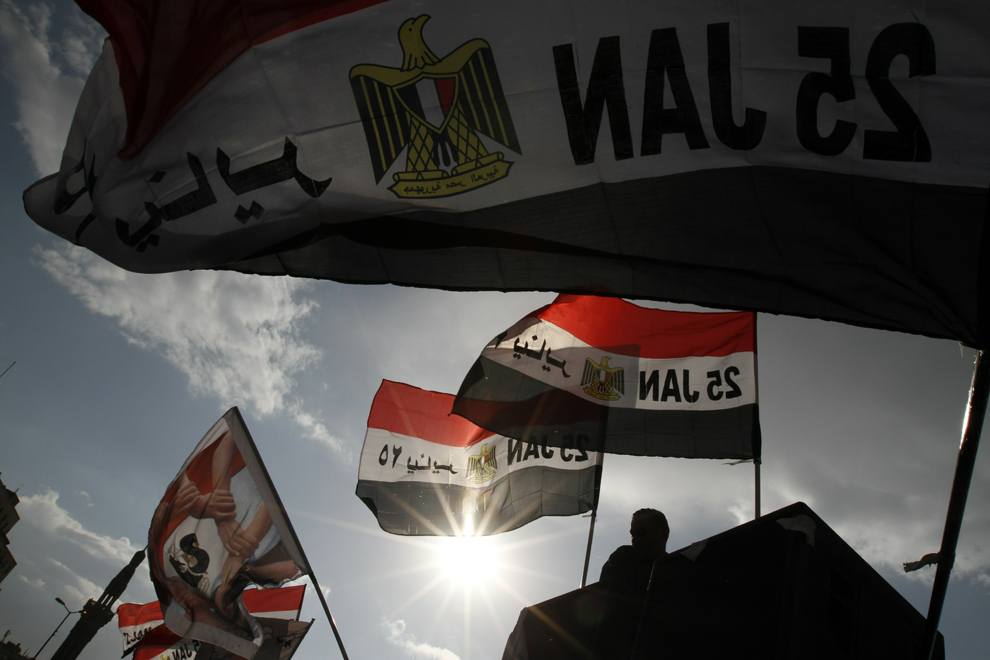
16Demonstrators wave their national flag that bear the date "January 25," referring to the first day of the start of protests calling for the ousting of President Mubarak. Since then, more than 300 people have been killed, according to human rights groups. (Mohammed Abed/AFP/Getty Images) #

17Opposition supporters wave flags in their stronghold of Tahrir Square. (Goran Tomasevic/Reuters) #

18President Hosni Mubarak makes a 17-minute statement to his nation in this image taken from television. Following more than two weeks of protests, anti-government demonstrators were given hope by official statements suggesting that Mubarak may step down after 30 years in power. But Mubarak said in his statement that while protester demands are legitimate, he won't give in to foreign dictates. (Egypt TV via APTN/Associated Press) #

19An opposition supporter reacts in dismay at President Hosni Mubarak's speech to the nation in their stronghold of Tahrir Square. (Suhaib Salem/Reuters) #

20Egyptian anti-government demonstrators wave their shoes as they show their anger during a speech by Egyptian President Hosni Mubarak, who failed to announce his immediate resignation, as tens of thousands gathered in Cairo's Tahrir Square. Embattled Mubarak delegated power to his deputy and former intelligence chief Omar Suleiman and proposed constitutional reforms but said the transition to end his 30-year-reign would last until September. (Pedro UgarteAFP/Getty Images) #

21Anti-government protesters watch on big screen as Egyptian President Hosni Mubarak makes a televised statement to his nation. Egyptian President Hosni Mubarak announced handing over some of his powers to his vice president, Omar Suleiman, and ordered constitutional amendments. But the move means he retains his title of president and ensures regime control over the reform process, falling short of protester demands. Protesters in Cairo's central Tahrir Square, hoping he would announce his resignation outright, reacted in fury and disbelief. (Emilio Morenatti/Associated Press) #

22Anti-government protesters react as Egyptian President Hosni Mubarak makes his statement. (Chris Hondros/Getty Images) #
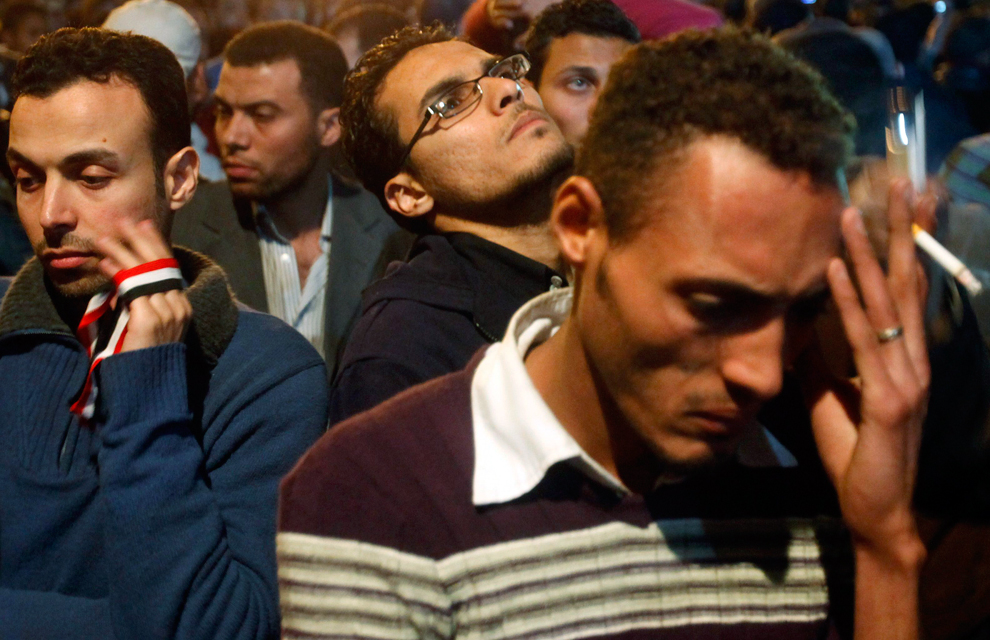
23Opposition supporters react in dismay at President Hosni Mubarak's speech to the nation. (Suhaib Salem/Reuters) #
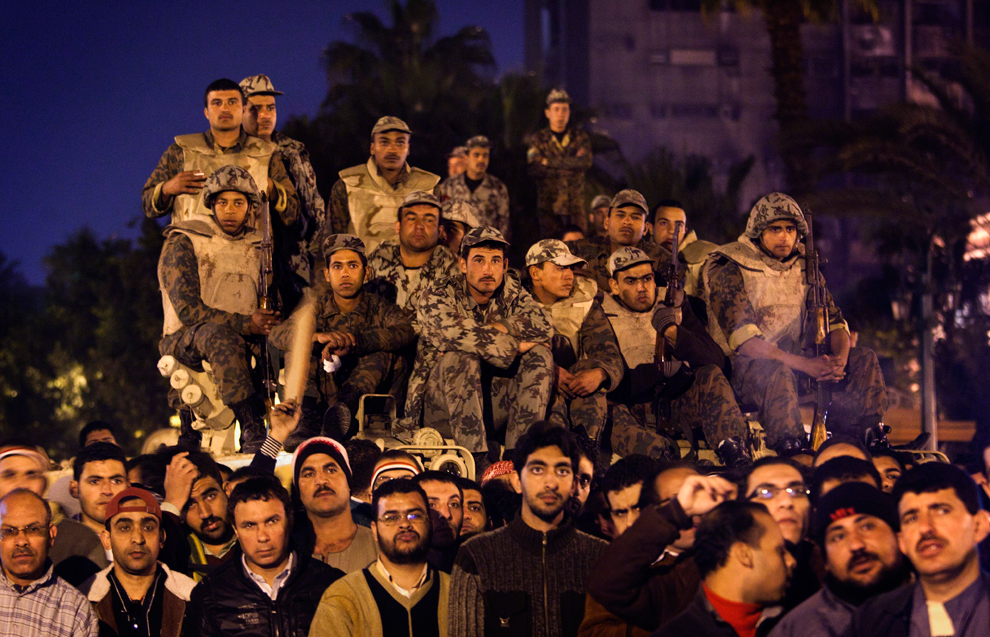
24Anti-government protesters and Army soldiers watch and listen to the statement of Egyptian President Hosni Mubarak. (Emilio Morenatti/Associated Press) #

25Anti-government protesters watch on a big screen as Egyptian President Hosni Mubarak makes a televised statement to his nation. (Emilio Morenatti/Associated Press) #

26The portrait of 18-year-old Egyptian anti-government protester Maath Sayed Mohammed Kamel, killed on January 28, 2011, sits next to an Egyptian flag at the place where he died during clashes between demonstrators and security forces in central Cairo's Tahrir Square, as the 18th day of protests against President Hosni Mubarak's regime began in the landmark square on February 11, 2011. (Pedro Ugarte/AFP/Getty Images) #
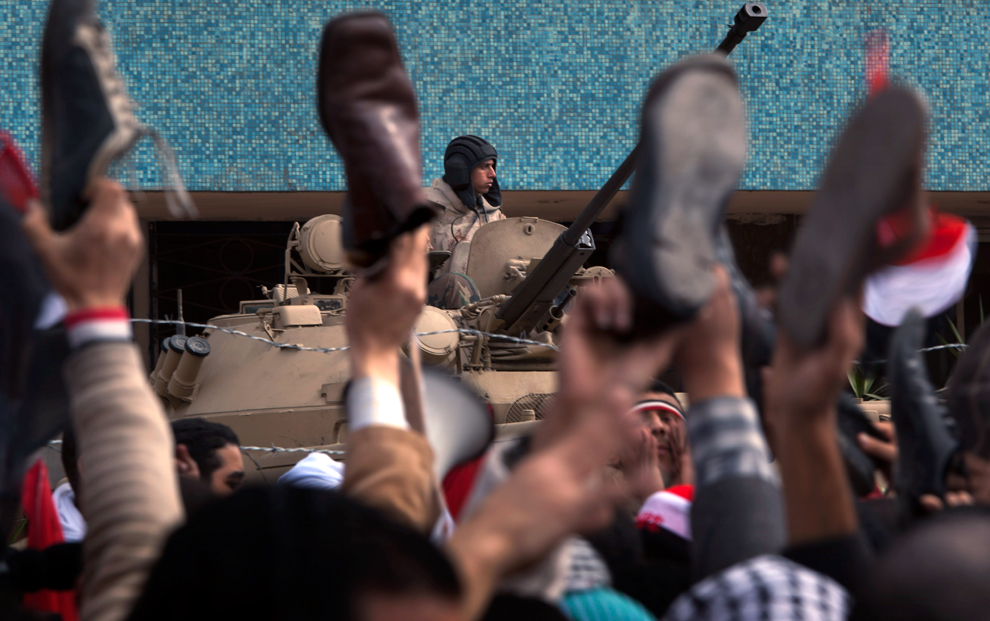
27An army soldier sits on a armored vehicle as anti-government protesters hold their shoes in the air during a protest in front of the state television building on the Corniche in downtown Cairo, Egypt Friday, Feb. 11, 2011. Stunned protesters, demanding his ouster, waved their shoes in contempt and shouted, "Leave, leave, leave." (Emilio Morenatti/Associated Press) #
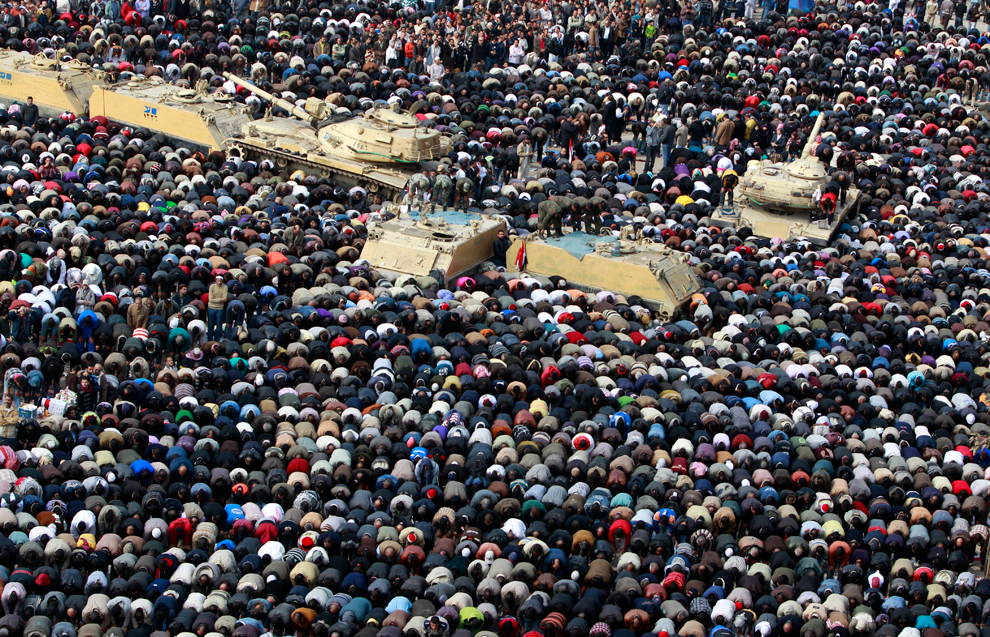
28Anti-government protesters and Egyptian Army soldiers on top of their vehicles, make traditional Muslim Friday prayers at the continuing demonstration in Tahrir Square, Friday, Feb. 11, 2011. (Ben Curtis/Associated Press) #

29Protesters weep during Friday prayers inside Tahrir Square. Egypt's powerful army pledged on Friday to guarantee President Hosni Mubarak's reforms in a move to defuse a popular uprising, but many angry protesters said this failed to meet their key demand that he resign immediately. (Dylan Martinez/Reuters) #
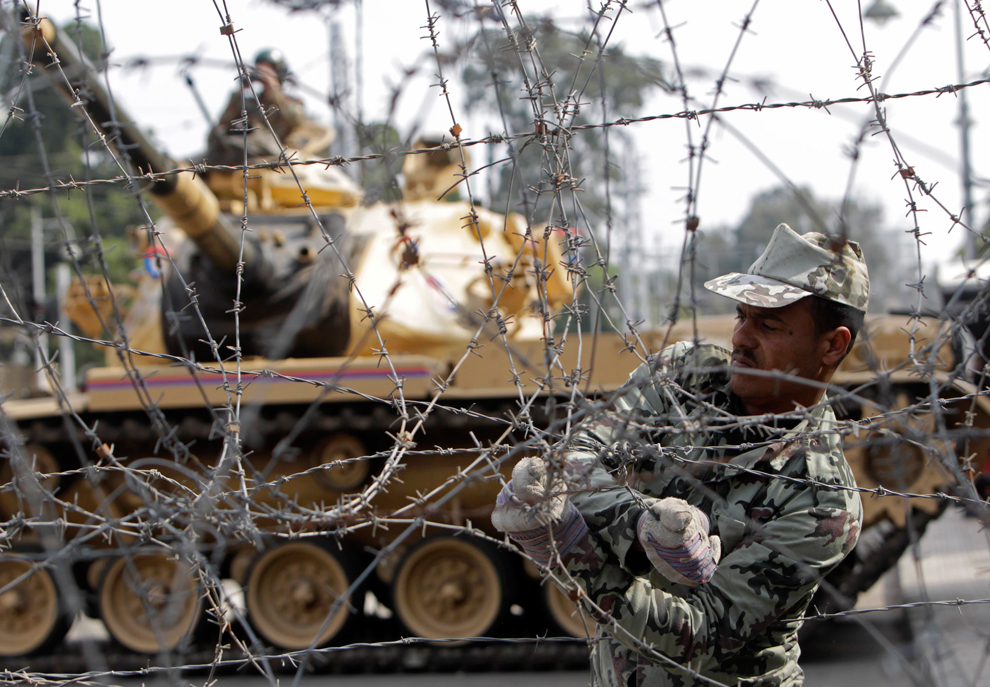
30A soldier pulls fencing into place in front of the presidential palace in Cairo. Egypt's powerful army gave guarantees on Friday that President Hosni Mubarak's promised reforms would be carried out, but protesters insisted he quit now and cranked up the pressure by massing outside his palace. (Amr Abdallah Dalsh/Reuters) #
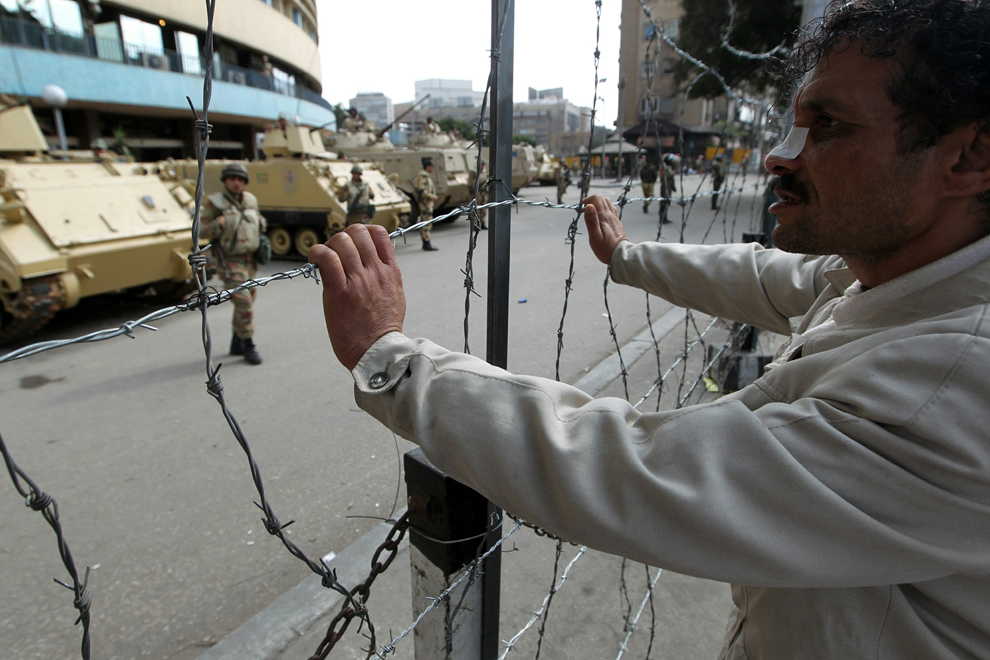
31An injured Egyptian anti-government protester holds onto barbed wires outside the state television building in Cairo. Thousands of demonstrators massed at Egypt's state television building and at President Hosni Mubarak's palace in the Cairo suburbs as anti-regime protests spread across the city. (Khaled Desouki/AFP/Getty Images) #

32An Egyptian soldier stands atop a tank guarding the state TV building on the Corniche in Cairo, as thousands of protesters demonstrate in the streets around the building. (Yannis Behrakis/Reuters) #
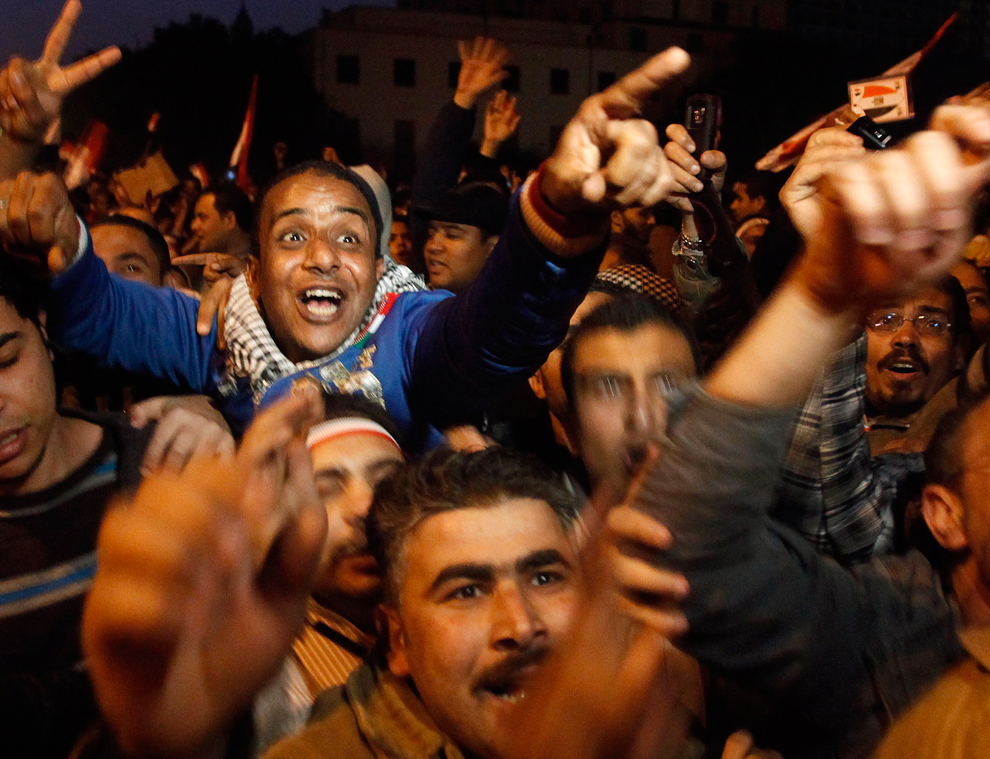
33Opposition protesters celebrate President Hosni Mubarak's resignation, from their stronghold of Tahrir Square. (Suhaib Salem/Reuters) #

34Cairo's streets exploded in joy when Mubarak stepped down after three-decades of autocratic rule and handed power to a junta of senior military commanders. (Mohammed Abed/AFP/Getty Images) #

35Anti-government protesters celebrate inside Tahrir Square after the announcement of Egyptian President Hosni Mubarak's resignation. (Dylan Martinez/Reuters)#

36Protesters celebrate inside Tahrir Square after the announcement that Mubarak had bowed to pressure from the street and had resigned, handing power to the army. (Dylan Martinez/Reuters) #

37The celebration continues. The crowd chanting "Egypt is free!" "Egypt is free!" (Dylan Martinez/Reuters) #

38An Egyptian anti-government demonstrator waves his national flag next to soldiers at Cairo's Tahrir Square in celebration. (Marco Longari/AFP/Getty Images) #

39An Egyptian boy kisses a soldier as anti-government protesters celebrate at Cairo's Tahrir Square. (Mohammed Abed/AFP/Getty Images) #

40An Egyptian woman cries as she celebrates the news of the resignation of President Hosni Mubarak, who stepped down after 30 years of power. (Tara Todras-Whitehill/Associated Press)
CONTINUE WITH 2011 MEMORIES WHICH SPREAD TO 2012
The transfer of prisoners: Israeli soldier Gilad Schalit is returned home in exchange for some 1,000 Palestinian prisoners
After being held captive by the Palestinian group Hamas for five years, Israeli soldier Gilad Schalit returned to his home in Mitzpe Hila, northern Israel. As his family and friends were celebrating his freedom, 477 of an eventual 1,027 Palestinians held in Israeli prisons were released to mass celebrations in the West Bank and Gaza Strip, part of the deal with Hamas. Schalit, a tank crewman who is now 25, was captured in June of 2006 near the Gaza border.
Israeli Chief of Staff Lieutenant General Benny Gantz embraced released Israeli soldier Gilad Schalit. Israeli Prime Minister Benjamin Netanyahu (right) and Defense Minister Ehud Barak also greeted him at Tel Nof Airbase on Oct. 18. Looking thin, weary, and dazed, Schalit returned home after more than five years of captivity in the Gaza Strip in exchange for hundreds of Palestinian prisoners whose joyful families greeted them with massive celebrations. (Israeli Government Press Office/Associated Press)

2Flag-waving Israelis greet the convoy carrying freed Israeli soldier Gilad Schalit as it made its way to his home in Mitzpe Hila, northern Israel, Oct. 18. (Moran Maayan/Associated Press) #

3People reacted as they saw the first images of Israeli soldier Gilad Schalit in Mitzpe Hila, northern Israel, Oct. 18. In the video, Schalit appeared thin and pale but otherwise healthy. (Oded Balilty/Associated Press) #

4An Israeli military helicopter carrying released soldier Gilad Schalit landed in Mitzpe Hila, northern Israel, Oct. 18. (Ariel Schalit/Associated Press) #
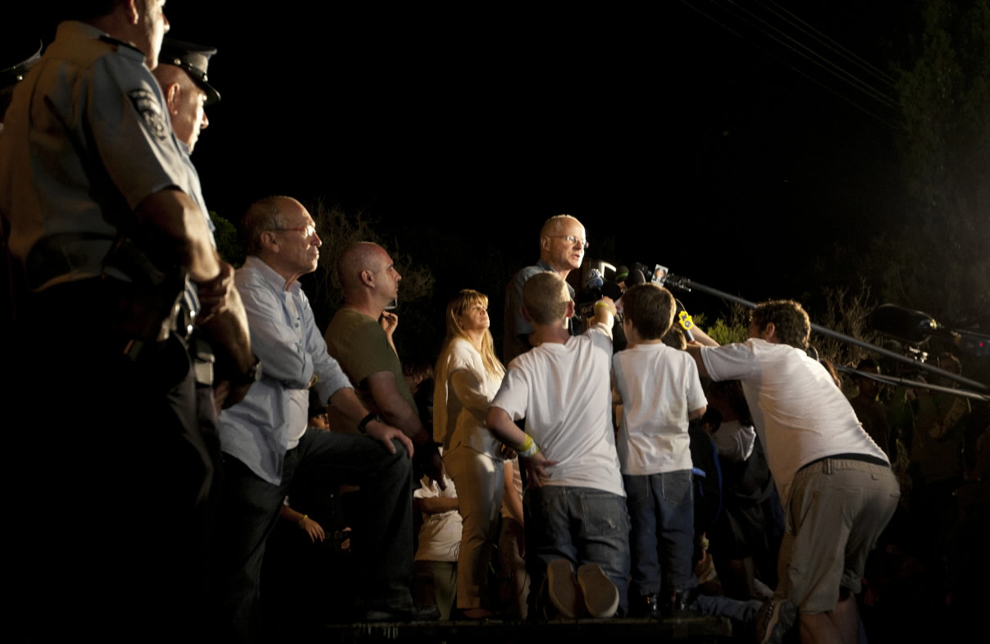
5Noam Schalit, father of released soldier Gilad Schalit, delivered a statement to the media in Mitzpe Hila, northern Israel, Oct. 18. He said, in part, "Today, we feel that we have experienced the birth of a new son. I wish to thank the public, all of you, those gathered here today to support us and greet Gilad with warmth and support, solidarity." (Ariel Schalit/Associated Press) #

6Released Israeli soldier Gilad Schalit was escorted by members of Hamas on the Egyptian side of the Rafah border crossing. Looking dazed, thin, and pale, Gilad Schalit emerged from a pickup truck on Oct. 18 under the escort of his Hamas captors and the Egyptian mediators who helped arrange the Israeli tank crewman's release after more than five years in captivity. (Khalid Farid/Associated Press) #

7Israeli soldier Gilad Schalit saluted Israeli Prime Minister Benjamin Netanyahu after arriving at the Tel Nof Air base in southern Israel. ( Israeli Government Press Office/Associated Press) #

8A woman cried upon seeing the first images of released Israeli soldier Gilad Schalit after more than five years in captivity, at the Tel-Nof Air Force base. (Sebastian Scheiner/Associated Press) #
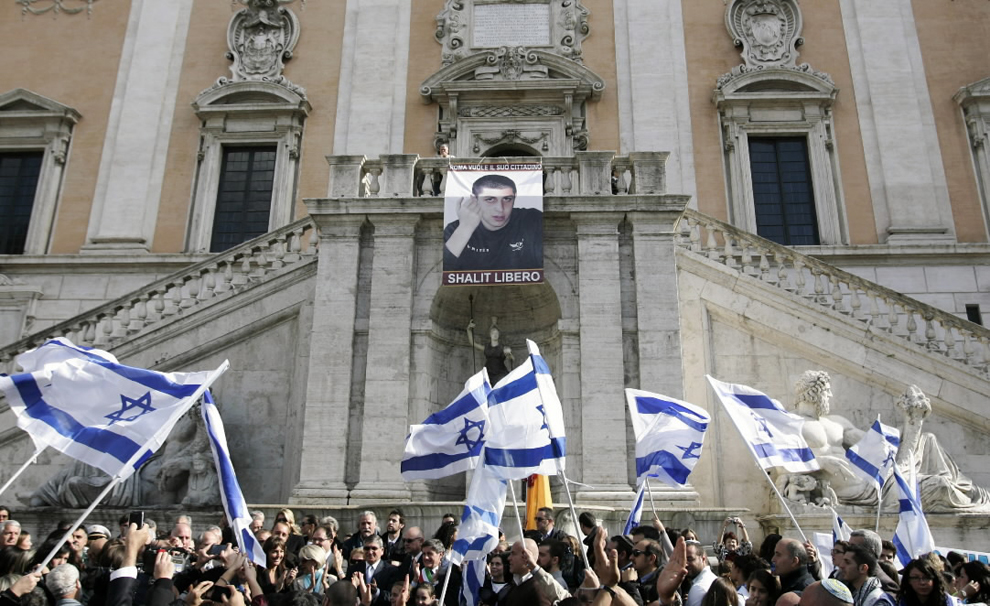
9Members of the Roman Jewish community waved Israeli flags as they celebrated the release of Israeli soldier Gilad Schalit, at Rome's Capitol Hill, Oct. 18. (Riccardo De Luca/Associated Press) #

10A Hamas security officer watched a crowd of Palestinians celebrating the release of prisoners at the main square in Gaza City, Oct. 18. Hamas agreed to release Israeli soldier Gilad Schalit in exchange for 1,027 Palestinian prisoners, many of them serving life sentences for deadly attacks on Israelis. The arrival of the prisoners set off celebrations in the West Bank and Gaza Strip, where large crowds and dignitaries greeted them. (Majed Hamdan/Associated Press) #

11The daughter of released Palestinian prisoner Walid Ghattas, who had been in prison for 20 years, cried as she waited for her meeting with Hamas political leader Khaled Meshal in Cairo on Oct. 18. Hundreds of Palestinians were freed from Israeli prisons in exchange for the release of Gilad Schalit, the Israeli soldier held for five years by the enclave's Islamist rulers, Hamas. (Amr Nabil/Associated Press) #

12Relatives waved to Palestinian prisoners freed from Israeli jails as their bus crossed into Egypt at the border crossing in Rafah, Egypt. (Nasser Nasser/Associated Press) #

13Alaeddin Ahmad Reza Albazian is carried on shoulders outside al-Aqsa mosque in Jerusalem, Oct. 18, after he was released from Israeli prison. (Awad Awad/Associated Press) #

14Palestinian prisoners who were freed from Israeli jails waved from a bus in Rafah, Egypt. (Khalil Hamra/Associated Press) #

15Egyptian police officers stood guard as a convoy of buses transporting freed Palestinian prisoners left the Egyptian terminal of the Gaza-Egypt border crossing in Rafah, Egypt. (Nasser Nasser/Associated Press) #

16Hamas leader Ismail Haniyeh (left) stood with released Palestinian prisoner Mohammed Al Hasani during a welcoming ceremony in Gaza City on Oct. 18. (Tara Todras-Whitehill/Associated Press) #

17Residents waved to Israeli military helicopters, one of them transporting released Israeli soldier Gilad Schalit, as they approached Mitzpe Hila, northern Israel, Oct. 18. (Ariel Schalit/Associated Press) #

18Israelis released a dove as they celebrated the return of Israeli soldier Gilad Shalit at the Kerem Shalom border crossing. (Tsafrir Abayov/Associated Press) #

19Released Israeli soldier Gilad Schalit was escorted by his father, Noam Schalit, Prime Minister Benjamin Netanyahu, and Defense Minster Ehud Barak at Tel Nof Air base in southern Israel on Oct. 18. (Israeli Government Press Office/Associated Press)
Egypt erupts with fresh protests
Protesters unhappy with the pace of change and the continued military rule in Egypt flooded Cairo's Tahrir Square over the weekend demanding civilian rule. Riot police responded with tear gas, beatings, and live ammunition, leaving at least 20 dead in continuing clashes. Egypt holds parliamentary elections next week, and demonstrators want presidential elections to be held shortly afterward. The ruling military has proposed to delay those elections until late 2012 or even 2013, angering Egyptians frustrated with the military's role in government. Collected here are images of the struggle over the weekend.
Protesters run from tear gas fired by riot police in a side street near Tahrir Square in Cairo November 21, 2011. (Goran Tomasevic/Reuters)

2Tens of thousands of Egyptian protesters wave national flags during a rally held in Cairo's Tahrir Square on November 18, 2011 with the aim of pushing Egypt's ruling military to cede power, 10 months after an uprising that toppled Hosni Mubarak's regime. (Khaled Desouki/AFP/Getty Images) #

3Tens of thousands of Egyptian protesters flood Tahrir Square in Cairo on November 18, 2011. (Khaled Desouki/AFP/Getty Images) #

4Riot police run toward protesters during clashes in a side street near Tahrir Square in Cairo November 21, 2011. (Goran Tomasevic/Reuters) #

5A protester clashes with riot police at Tahrir Square in Cairo November 19, 2011. Riot police on Saturday cleared the square of protesters who had camped overnight after a rally of some 50,000 people, mainly Islamists, pressed Egypt's military rulers to transfer power swiftly to a civilian government. Around 100 protesters had stayed in the square, where police pulled down tents and confiscated chairs and banners they had set up, Reuters' witnesses said. Some minor scuffles occurred. (Mohamed Abd El-Ghany/Reuters) #

6Egyptian riot police clash with protesters at Tahrir Square in Cairo November 19, 2011. (Mohamed Abd El-Ghany/Reuters) #

7A protester throws a tear gas canister, which had earlier been thrown by riot police, near Tahrir Square in Cairo November 20, 2011. Protesters demanding an end to army rule and angered by rough police tactics battled with police on Sunday, presenting Egypt's ruling generals with their biggest security challenge yet, a week before parliamentary elections. Two people were killed and hundreds wounded in clashes on Saturday night reminiscent of some of the worst violence during the 18-day uprising that toppled Hosni Mubarak in February. (Mohamed Abd El-Ghany/Reuters) #

8Protesters help their fellow protester, who is affected by tear gas, during clashes with riot police near Tahrir Square in Cairo November 20, 2011. (Asmaa Waguih/Reuters) #

9Protesters chant slogans and carry a giant Egyptian flag during clashes with riot police in Tahrir Square in Cairo November 20, 2011. (Mohamed Abd El-Ghany/Reuters) #

10A wounded protester is treated at a field hospital during clashes with Egyptian riot police in Tahrir Square in Cairo November 20, 2011. (Amr Abdallah Dalsh/Reuters) #

11A wounded protester is rushed to a field hospital near Tahrir Square during clashes with Egyptian riot police in Cairo November 20, 2011. (Amr Abdallah Dalsh/Reuters) #

12Men mourn next to the body of a protester at a field hospital near Tahrir Square, after he was killed during clashes with Egyptian riot police in Cairo November 20, 2011. (Amr Abdallah Dalsh/Reuters) #

13A wounded protester holds spent ammunition at a field hospital near Tahrir Square, during clashes with Egyptian riot police, in Cairo November 20, 2011. (Amr Abdallah Dalsh/Reuters) #

14A protester has his eyes washed with milk to protect against tear gas during clashes with police in Cairo November 21, 2011. (Goran Tomasevic/Reuters) #

15A protester climbs a burning building to rescue residents trapped by fire during clashes with police in Cairo November 21, 2011. (Goran Tomasevic/Reuters) #

16Protesters help people climb down a burning building during clashes with police on a road which leads to the Interior Ministry near Tahrir Square in Cairo November 21, 2011. Egypt's Health Ministry said on Monday that the death toll in clashes between protesters and security forces in Cairo's Tahrir Square reached 20 people. (Amr Abdallah Dalsh/Reuters) #

17A protester sits in a broken window at a damaged building belonging to The American University in Cairo as he watches the clashes near Tahrir Square in Cairo November 21, 2011. (Amr Abdallah Dalsh/Reuters) #

18Tens of thousands of Egyptian protesters perform the Friday prayer during a rally in Cairo's Tahrir Square on November 18, 2011 with the aim of pushing Egypt's ruling military to cede power. (Khaled Desouki/AFP/Getty Images) #

19Protesters prepare to throw Molotov cocktails during clashes with riot police in a side street near Tahrir Square in Cairo November 21, 2011. (Goran Tomasevic/Reuters) #

20Protesters take cover behind a makeshift barricade and a burnt car as riot police fire tear gas and rubber-covered bullets in a side street near Tahrir Square in Cairo November 21, 2011. Cairo's main morgue at Zainhum hospital has received 33 corpses from those killed in clashes between protesters and security forces, medical sources said on Monday. (Goran Tomasevic/Reuters) #

21Protesters run away from riot police firing tear gas and rubber-covered bullets in a side street near Tahrir Square in Cairo November 21, 2011. (Goran Tomasevic/Reuters) #

22Protesters carry a man injured during clashes with riot police in a side street near Tahrir Square in Cairo November 21, 2011. (Goran Tomasevic/Reuters) #

23Protesters run from riot police firing tear gas and rubber-covered bullets in a side street near Tahrir Square in Cairo November 21, 2011. (Goran Tomasevic/Reuters) #

24A protester throws stones at riot police during clashes in a side street near Tahrir Square in Cairo November 21, 2011. (Goran Tomasevic/Reuters)
Taking the vote: elections in Egypt
Hours after violent clashes between masses of protesters and police, Egyptians swarmed the polls early this week for the beginning rounds of parliamentary elections. They are the first elections since a prodemocracy uprising ousted longtime president Hosni Mubarak from office earlier this year. The poll stations have been remarkably peaceful, despite the simmering anger over the military’s extended role in running the government. In contrast, the Democratic Republic of Congo's presidential and legislative elections this week were beset by fraud, some observers say. In one town, rebel fighters attacked a polling place, killing at least five people and burning ballots. The voting was Congo's second since the end of the country's last war and the first organized by the government rather than the international community.
A man waits outside a polling station to cast his vote during parliamentary elections in Cairo Nov. 28. (Amr Abdallah Dalsh/Reuters)

2An old man casts his vote at a polling station during parliamentary elections in Cairo Nov. 28. Egyptians lined up to vote in the first big test of a transition born in popular revolutionary euphoria that soured into distrust of the generals who replaced their leader, Hosni Mubarak. (Ahmed Jadallah/Reuters) #

3An Egyptian voter passes between the hands of soldiers guarding at a polling center Nov. 28 in Cairo, Egypt. Voting began on Monday in Egypt's first parliamentary elections since longtime authoritarian leader Hosni Mubarak was ousted in a popular uprising nine months ago. The vote is a milestone many Egyptians hope will usher in a democratic age after decades of dictatorship. (Amr Nabil/Associated Press) #

4In a combination image made from six photos, Egyptian women pose with their inked fingers after voting at a polling station in Cairo Nov. 29. Long lines formed at polling stations for a second day of voting and the head of the election commission, Abdel-Mooaez Ibrahim, proclaimed turnout so far had been "massive and unexpected." But he did not give figures. (Bela Szandelszky/Associated Press) #

5An old man is carried by a volunteer after casting his vote at a polling station during parliamentary elections in Cairo Nov. 28. (Amr Abdallah/Reuters) #

6A woman reads a ballot paper before casting her vote at a polling station during the parliamentary election in Alexandria Nov. 29. (Mohamed Abd El-Ghany/Reuters)#

7An Egyptian woman looks at voters as they line up outside a polling station in the Shubra district of Cairo on Nov. 28. Post-revolution Egypt headed to the polls for a chaotic election clouded by violence and a political crisis, the start of a long process to bring democracy to the Arab world's most populous nation. (Mohammed Hossam/AFP/Getty Images) #

8Egyptian soldiers stand guard at the entrance of a school turned polling station as voters gather in the Ain Shams district of Cairo on Nov. 28. (Amro Maraghi/AFP/Getty Images) #

9Egyptian voters waited at a school turned polling station in old Cairo on Nov. 28. (Odd Andersen/AFP/Getty Images) #

10A woman carrying her child reads a ballot paper before casting her vote at a polling station during parliamentary elections in Cairo Nov. 29. (Amr Abdallah Dalsh/Reuters) #

11A man stood in front of banners supporting candidates for the parliamentary elections in Cairo Nov. 28. (Goran Tomasevic /Reuters) #

12Egyptian women vote at a polling station in the town of Ibshawai, near Fayoum, 100 km (62 miles) southwest of Cairo Nov. 29. Polls opened Tuesday for a second day of voting in Egypt's landmark parliamentary elections, the first since Hosni Mubarak's ouster in a popular uprising earlier this year. (Tara Todras-Whitehill/Associated Press) #

13A Egyptian woman casts her ballot in Maadi, a suburb of Cairo Nov. 28. Voting began on Monday in Egypt's first parliamentary elections since longtime authoritarian leader Hosni Mubarak was ousted in a popular uprising nine months ago. The vote is a milestone many Egyptians hope will usher in a democratic age after decades of dictatorship. (Tara Todras-Whitehill/Associated Press) #

14People line up at a polling station as they wait to cast their votes during parliamentary elections in Cairo Nov. 28. (Amr Abdallah Dalsh/Reuters) #

15People gathered outside a polling station to vote in the parliamentary election in Shubra neighborhood of Cairo Nov. 2. (Goran Tomasevic/Reuters) #

16Egyptian soldiers stand guard as voters leave a polling station in Cairo Nov. 29. Polls opened Tuesday for a second day of voting in Egypt's landmark parliamentary elections. (Bela Szandelszky/Associated Press) #

17Egyptian women look at a ballot paper at a polling station in the Sahel district of Cairo Nov. 28. Post-revolution Egypt headed to the polls for a chaotic election clouded by violence and a political crisis, the start of a long process to bring democracy to the Arab world's most populous nation. (Mohammed Hossam/AFP/Getty Images) #

18Egyptian elections officials burn wax to stamp a ballot box before sending it to a counting center in Cairo Nov. 29. Polls opened Tuesday for a second day of voting in Egypt's landmark parliamentary elections, the first since Hosni Mubarak's ouster in a popular uprising earlier this year. The Arabic on the box reads, "parliamentary elections.
Egyptians gather in Tahrir Square to mark anniversary of uprising
A massive demonstration of Egyptians gathered in Tahrir Square in Cairo today to mark the anniversary of the uprising that eventually led to the ousting of President Hosni Mubarak. Political divides are still in force with liberals and Islamists differing on their visions for the future of the country. Mubarak is now on trial for complicity in the deaths of protesters. The uprising in Egypt last year was one of the initial protests of what is called the Arab Spring, which has included the slaying of Libyan leader Moammar Khadafy and the ongoing protests in Syria.
Egyptians gather in their thousands in Tahrir Square to mark the one year anniversary of the revolution on Jan. 25, 2012 in Cairo Egypt. Tens of thousands have gathered in the square on the first anniversary of the Arab uprising which toppled President Hosni Mubarak. (Jeff J Mitchell/Getty Images)

2Egyptian men chants slogans as thousands gather in Tahrir Square to mark the one year anniversary of the uprising that ousted President Hosni Mubarak in Cairo, Egypt on Jan. 25. (Muhammed Muheisen/Associated Press) #

3A woman speaks as Egyptians gather in Tahrir Square to mark the one year anniversary of the revolution on Jan. 25, 2012 in Cairo Egypt. Tens of thousands are gathering in the square on the first anniversary of the Arab uprising which toppled President Hosni Mubarak. (Jeff J Mitchell/Getty Images) #

4Demonstrators pray at Tahrir Square during a protest marking the first anniversary of Egypt's uprising in Cairo on Jan. 25. (Suhaib Salem/Reuters) #

5A huge national flag (right) and the Syrian flag are held up as tens of thousands of Egyptians gather for a mass rally in Cairo's Tahrir Square on Jan. 25 marking the first anniversary of the uprising that toppled president Hosni Mubarak as a debate raged over whether the rally was a celebration or a second push for change. (Mahmus Hams/AFP/Getty Images) #

6Egyptian Muslim Brotherhood Elder Safwat Hegazy is carried through Tahrir Square as thousands gather to mark the one year anniversary of the revolution on Jan. 25 in Cairo Egypt. Tens of thousands have gathered in the square on the first anniversary of the Arab uprising which toppled President Hosni Mubarak. (Jeff J Mitchell/Getty Images) #

7Egyptians march during a demonstration toward Tahrir Square marking the first anniversary of the popular uprising that unseated President Hosni Mubarak. (Associated Press) #

8An Egyptian man holds a newspaper with a photo of the opening session of parliament as thousands gather in Tahrir Square to mark the one year anniversary of the uprising that ousted President Hosni Mubarak in Cairo, Egypt on Jan. 25. #

9A demonstrator waves an Egyptian flag during a protest marking the first anniversary of Egypt's uprising at Tahrir square in Cairo on Jan. 25. (Reuters) #

10An Egyptian man wears face paint in the colors of the national flag in Tahrir Square as thousands gather to mark the one year anniversary of the uprising that ousted President Hosni Mubarak. (Muhammed Muheisen/Associated Press) #

11Egyptian woman looks on during a rally in Tahrir Square to mark the one year anniversary of the revolution on Jan. 25 in Cairo Egypt. Tens of thousands are gathering in the square on the first anniversary of the Arab uprising. (Jeff J Mitchell/Getty Images) #

12An Egyptian man holds a copy of the Koran in one hand and a wooden cross in the other during a mass rally in Tahrir Square. (Khaled Desouki/AFP/Getty Images) #

13A young child has his face painted with the date 25 as Egyptians gather in Tahrir Square to mark the one year anniversary of the revolution on Jan. 25. (Jeff J Mitchell/Getty Images) #

14A protester wears a mask depicting slain Coptic activist Mina Daniel as they march in the suburb of Shobra, on their way to join a rally in Tahrir Square in Cairo. (Nasser Nasser/Associated Press0 #

15An Egyptian woman uses a spray paint can to write in Arabic, "down with military rule," during a demonstration marking the first anniversary of the popular uprising that unseated President Hosni Mubarak in Giza, Egypt. (Khalil Hamra/Associated Press) #

16A man prays next to a security barrier in Tahrir Square during a rally to mark the one year anniversary of the uprising that ousted President Hosni Mubarak in Cairo, Egypt on Jan. 25. Tens of thousands of Egyptians rallied Wednesday to mark the first anniversary of the country's 2011 uprising, with liberals and Islamists gathering on different sides of Cairo's Tahrir Square in a reflection of the deep political divides that emerged in the year since the downfall of longtime leader Hosni Mubarak. The graffiti at right, in Arabic, reads at top, "freedom," and below "down with the military rule." (Muhammed Muheisen/Associated Press) #

17An Egyptian child attends a rally in Tahrir Square to mark the one year anniversary of the revolution on Jan. 25. (Jeff J Mitchell/Getty Images) #

18The Egyptian national flag is seen reflected in a puddle of water during a demonstration marking the first anniversary of the popular uprising that unseated President Hosni Mubarak. (Khalil Hamra/Associated Press) #

19Egyptians gather in the thousands in Tahrir Square to mark the one year anniversary of the revolution on Jan 25 in Cairo, Egypt. (Jeff J Mitchell/Getty Images) #

20Tens of thousands of Egyptians wave national flags during a mass rally in Tahrir Square on Jan. 25 marking the first anniversary of the uprising that toppled Hosni Mubarak as a debate raged over whether the rally was a celebration or a second push for change. (Khaled Dedouki/AFP/Getty Images) #

21Silhouetted against the national flag some of the tens of thousands of Egyptians gather for a mass rally in Cairo's Tahrir Square on Jan. 25. (Mahmud Hams/AFP/Getty Images) #

22Egyptian protesters hold a large banner depicting Gen. Hussein Tantawi (left) former President Hosni Mubarak (center) and former interior minister Habib al-Adly in nooses with Arabic writing that reads, "The peoples rule," in Tahrir Square during a rally to mark the one year anniversary of the uprising that ousted President Hosni Mubarak in Cairo, Egypt on Jan. 25. (Muhammed Muheisen/Associated Press) #

23A demonstrator acts as a martyr to symbolize people killed during the revolution during a protest marking the first anniversary of Egypt's uprising at Tahrir square in Cairo on Jan. 25 (Mohamed Abd El-Ghany/Reuters) #

24Demonstrators take part in a protest marking the first anniversary of Egypt's uprising at Tahrir Square in Cairo on Jan. 25. (ohamed Abd El-Ghany/Reuters) #
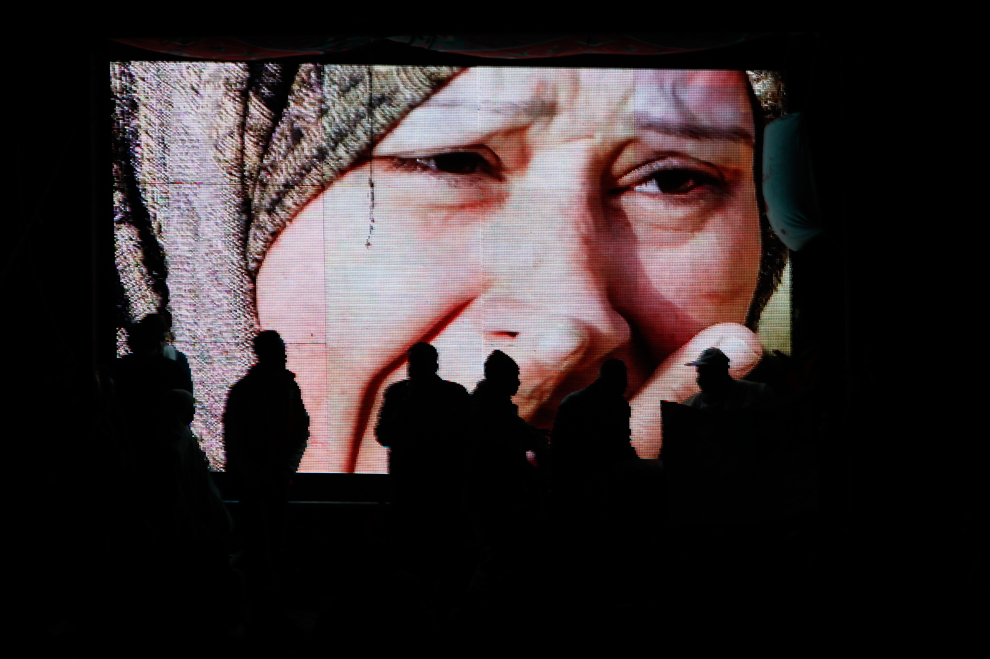
25A video presentation on families of those killed in clashes with Egyptian security forces is broadcast in Tahrir Square after sundown in Cairo, Egypt on Jan. 25. Tens of thousands of Egyptians rallied Wednesday to mark the first anniversary of the country's 2011 uprising, with liberals and Islamists gathering on different sides of Cairo's Tahrir Square in a reflection of the deep political divides that emerged in the year since the downfall of longtime leader Hosni Mubarak. (Nasser Nasser/Associated Press) #
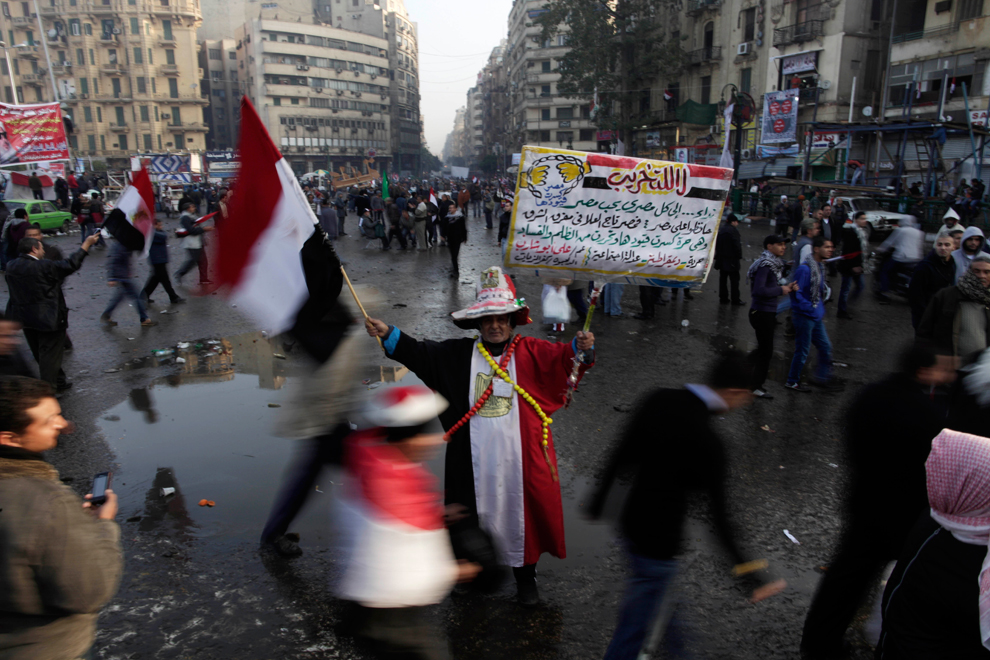
26An Egyptian protester wearing the national flag holds a sign that reads, in Arabic, "no to destruction a call to all Egyptians that love Egypt, save Egypt," as thousands gather in Tahrir Square to mark the one year anniversary of the uprising that ousted President Hosni Mubarak. (Muhammed Muheisen/Associated Press) #

27Egyptians hold pictures of former President Gamal Abdel Nasser and a placard that reads, in Arabic, "we did not come to celebrate, we came to continue this revolution," as thousands gather in Tahrir Square to mark the one year anniversary of the uprising that ousted President Hosni Mubarak in Cairo, Egypt on Jan. 25. (Muhammed Muheisen)/Associated Press) #

28Protesters stand beneath a giant Egyptian flag as they march in the suburb of Shobra, on their way to join a rally in Tahrir Square in Cairo, Egypt on Jan. 25. Tens of thousands of Egyptians rallied Wednesday to mark the first anniversary of the country's 2011 uprising, with liberals and Islamists gathering on different sides of Cairo's Tahrir Square in a reflection of the deep political divides that emerged in the year since the downfall of longtime leader Hosni Mubarak. (Nasser Nasser)/Associated Press) #
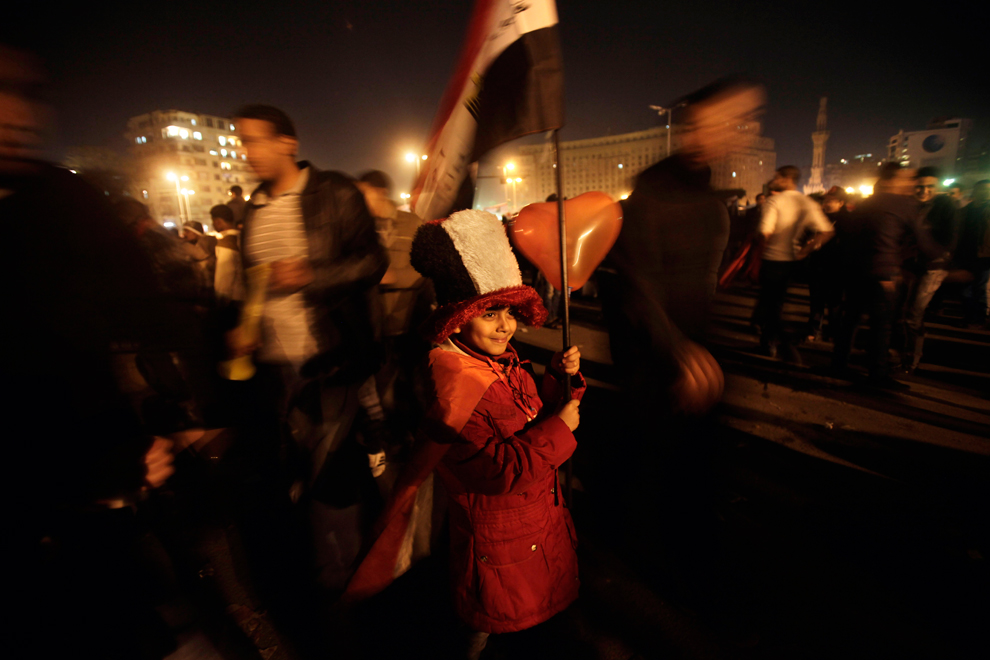
29Rahmah Mohammed (9) waves an Egyptian national flag at a rally in Tahrir Square to mark the one year anniversary of the uprising that ousted President Hosni Mubarak. (Muhammed Muheisen/Associated Press) #

30Egyptian protesters lift an obelisk with the names of those killed during last year's uprising, at a huge rally in Tahrir Square on Jan. 25 marking the first anniversary of the uprising that toppled president Hosni Mubarak as a debate raged over whether the rally was a celebration or a second push for change. (Mahmud Hams/AFP/Getty Images) #

31Egyptian protesters gather in Tahrir Square on Jan. 25, 2012, during a mass rally marking the first anniversary of the uprising that toppled Hosni Mubarak. (Mahmud Hams/AFP/Getty Images)
Egypt: protests over Port Said soccer deaths
Violence at a soccer match triggered intensified political protests in Egypt raging now into their fifth day. A match on February 1, 2012 in Port Said, Egypt between rival clubs Al-Masry of Port Said and visiting Al-Ahly of Cairo ended with home supporters charging onto the pitch and chasing visiting fans. That confrontation turned bloody when the visiting fans were unable to get out of the stadium, and 74 died from attacks and from injuries sustained in a panicked stampede. Al-Ahly's fans had played a prominent role in defending protests in Cairo's Tahrir Square that eventually toppled leader Hosni Mubarak, and for this reason opponents of Egypt's military rulers assert that police at the stadium allowed the violence to happen, or even encouraged it. Protests continue to grow over the lack of police protection for the fans after three official days of mourning for the victims. Gathered here are photographs of the initial confrontation between fans and the resulting protests from the past several days.
Protests near Egypt's Interior Ministry continued on February 3, 2012 in Cairo, Egypt with at least four people killed amid anger over the deaths of 74 football fans that were killed in clashes between rival fans in Port Said, Egypt. Three-days of mourning were announced and marches were scheduled to protest at the lack of protection provided by police who were at the stadium when the violence occurred.

2Flares are thrown in the stadium during clashes that erupted after a football match between Egypt's Al-Ahly and Al-Masry teams in Port Said on February 1, 2012. (STR/AFP/Getty Images) #

3Fans of Al-Masry team run after players of the Al-Ahly team during riots that erupted after the football match between the two teams in Port Said on February 1, 2012. (STR/AFP/Getty Images) #

4An Egyptian soldier checks on a wounded football fan of Al-Ahly as he lies on a stretcher upon his arrival in Cairo aboard a military plane on February 2, 2012. (STR/AFP/Getty Images) #

5Egyptian women mourn at a morgue in Cairo on February 2, 2012, after 74 people were killed on February 1 at a football match in the northern city of Port Said. Egypt began three days of official mourning as anger grew against the military rulers for failing to ensure security. (Mahmud Hams/AFP/Getty Images) #

6Family members and mourners gather at Cairo's railway station as they receive the bodies of 74 football fans who were killed during clashes between rival fans following a match at Port Said on February 2, 2012. All Egyptian football matches have been postponed indefinitely. (Ed Giles/Getty Images) #

7An Egyptian protester walks amid tear gas fired by riot police during clashes near the Interior Ministry in Cairo on February 2, 2012. (Mahmud Hams/AFP/Getty Images) #

8A protester suffering the effects of tear gas inhalation is treated in a triage unit February 2, 2012 in Cairo. (Ed Giles/Getty Images) #

9Protesters stand on a concrete wall built during previous clashes on February 2, 2012 in Cairo. (Ed Giles/Getty Images) #

10A protester suffering from the effects of tear gas inhalation falls to the ground during clashes between protesters and riot police near the Interior Ministry on February 3, 2012 in Cairo. (Carsten Koall/Getty Images) #

11Egyptian riot police charge towards protesters near Egypt's Interior Ministry as violent demonstrations continued on February 3, 2012 in Cairo. (Ed Giles/Getty Images) #

12Protesters throw stones during clashes between protesters and egyptian riot police near the Interior Ministry on February 3, 2012 in Cairo. (Carsten Koall/Getty Images) #

13A protester suffering from the effects of tear gas inhalation falls to the ground during clashes between protesters and riot police near the Interior Ministry on February 3, 2012 in Cairo. (Carsten Koall/Getty Images) #

14A protester suffering from the effects of tear gas inhalation falls to the ground during clashes between protesters and riot police near the Interior Ministry on February 3, 2012 in Cairo. (Carsten Koall/Getty Images) #

15An Egyptian riot policeman fires tear gas during clashes with protesters near the Interior Ministry in Cairo on February 3, 2012. (Khaled Desouki/AFP/Getty Images) #

16Egyptian protesters run for cover from the tear gas fired by riot police near the Interior Ministry in Cairo on February 3, 2012. (Khaled Desouki/AFP/Getty Images)#

17An Egyptian protester throws a tear gas canister back at riot police in Cairo on February 4, 2012. (Khaled Desouki/AFP/Getty Images) #

18Egyptian security forces detain a press photographer during clashes near the Interior Ministry in Cairo on February 5, 2012. (Stringer/Reuters) #

19An Egyptian protester has his eyes treated after being exposed to tear gas near the Interior Ministry in Cairo on February 5, 2012 as deadly clashes raged into a fourth day. (Mahmud Hams/AFP/Getty Images) #

20Egyptian protesters are engulfed in a cloud of tear gas as they gather at a barricade erected against the riot police near the central Tahrir Square in Cairo on February 5, 2012. (Marco Longari/AFP/Getty Images) #

21A protester shows his collection of empty cartridges during clashes with security forces near the Interior Ministry in Cairo on February 6, 2012. (Mohammed Salem/Reuters) #

22Protesters react to tear gas during clashes with security forces near the Interior Ministry in Cairo on February 6, 2012. (Mohammed Salem/Reuters) #

23An Egyptian demonstrator evacuates a wounded comrade during ongoing clashes with riot police outside Cairo's security headquarters on February 6, 2012 in the wake of deadly football violence and amid calls by activists for civil disobedience in Egypt. (Marco Longari/AFP/Getty Images) #

24An Egyptian protester grabs a tear gas canister fired by riot police near the Interior Ministry during clashes with riot police in Cairo on February 6, 2012. (Mahmud Hams/AFP/Getty Images) #

25A wounded Egyptian demonstrator is carried away by other youths during confrontations with riot police in Cairo on February 6, 2012. (Marco Longari/AFP/Getty Images) #
Collected,Edited And Reported By:
Pilot: Tarek Elagamy








No comments:
Post a Comment
Note: Only a member of this blog may post a comment.